#well minus the last few pages that weren’t available
Explore tagged Tumblr posts
Text






Lesbian Terminology in Thailand
Asian American Sexualities: Dimensions of the Gay and Lesbian Experience edited by Russell Leong (1996)
#lesbian#books/articles/text#terminology#loc#gnc#thailand#asia#lgbt history#lgbtq#lesbianism#don’t have access to the full book so i just read this chapter#well minus the last few pages that weren’t available
17 notes
·
View notes
Text
Role Club Engineers: Worth the Wait?

Introduction (Part I): History of Engineer Boots
Engineer boots are definitely a polarizing style of footwear within the heritage/amekaji boot community. For one, they utilize an ankle strap for fastening in lieu of laces, and second, their tall stovepipe shafts don’t integrate quite well with the slim tapered esthetic of modern denim/trousers. While often associated with motorcycles and bikers, engineer boots were actually designed as protective gear for firemen working on railway engines back in the 1930s. (Hence the name “engineers.”) Their minimal design and use of buckles over laces made them ideal for this line of work. The tall shafts provided protection for the lower leg, while the slip-on design allowed for quick removal should anything dangerous (such as hot coals or embers) slip down the shaft into the boot. This style of footwear lost some popularity following the introduction of lace-up combat boots during World War II, but would later be picked up by motorcyclists who found use of their insulating and protective features. (And there is your history lesson for the day, courtesy of Wikipedia. Lol)
Introduction (Part II): How I Got into Engineer Boots
I first got into more well-made boots back in early 2019. Like most boot n3wbs, I was completely infatuated by that lace-up service boot esthetic, and insisted on wearing them with the slimmest, most tapered denim I could find. My first boot purchase was (of course) a pair of Red Wing Iron Rangers, followed by three pairs of Truman service boots in pretty quick succession. That first summer was when I discovered @brianthebootmaker on Instagram and YouTube, and instantly fell in love with his Underdog design, which I later purchased in August 2019 and received in May 2020.

At that point in time, Brian’s popular Underdog boots fit perfectly within my slim service boot style. However, Brian’s most iconic boot pattern was (and is) definitely his engineer boots. I admit I wasn’t sold on them at first, but I was intrigued. Did they fit my wardrobe at all? Nope. Would they even fit under the 6.75” leg openings of my PBJ denim? LOL nah. Nevertheless, I found myself constantly going back to Brian’s Instagram page and browsing all the photos of his engineer boots. Eventually, I grew to really love the look of engineer boots, ultimately placing a second deposit with Brian for a pair of engineers in October 2019. I had no idea how I was going to fit them into my wardrobe, but I figured I’d make it work somehow. (Luckily, since then my denim preferences have actually shifted toward more relaxed cuts, just in time for the arrival of these engineers.)
The Ordering Process
For most customers purchasing online, Brian requires you to take a set of measurements on your own feet, which he uses to build your boots remotely. However, those lucky enough to live nearby can actually visit Brian’s shop in LA to be personally measured by the boot maker himself, as well as discuss any details or questions you have regarding your specific makeup. I was one of these lucky people who could actually visit him in person, and used those measurements to order two pairs of boots from him: first a pair of Underdogs, and now some engineers. Both pairs were built on different lasts (which I will discuss more later), and both fit perfectly. (For a more detailed summary of being measured in person, check out my previous review of my Role Club Underdogs.)

My Specifications
While you can’t really go wrong with any of Brian’s engineer makeups, I personally loved the design Brian designed for himself: brown CXL horsehide hand-finished black, a full leather outsole, and full woodsman heels. They definitely have a more western, cowboy, workwear vibe compared to most other engineer boots out on the market, but in my opinion these are one of the best patterns, with some of the cleanest construction to boot.

A few screenshots I took of Brian's engineer boots, taken off his Instagram.
I did make a few tweaks/upgrades from Brian’s boots when designing my own, which I’ve listed below:
Model: engineer boots
Shaft height: 10”
Upper leather: brown Italian vegtan horsebutt, hand-finished black
Toe track: yes
Upper stitching: black
Hardware: brass roller buckles
Last: 2307 last
Unstructured toe
Edge finish: black
Welt stitching: white
Sole: full leather sole, black heel cap
Heel style: full woodsman heel
Metal toe plates
Custom built-in orthotics (same as my Underdogs)
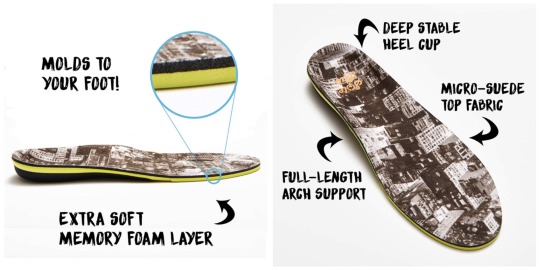
One of the biggest reasons I keep going back to Brian is that he’s able to use the orthotics I typically slip into all my footwear and actually build them into the insoles of my boots. Not sure how difficult this actually is for a boot maker, but Brian has absolutely nailed the fit on my ugly feet both times, and it’s super convenient to not have to worry about a removable orthotics.
Price, Lead Time, & Shipping
The initial deposit to reserve a pair of Role Club boots is $200 regardless of which model you are ordering, with the remaining balance due upon completion. I visited Brian’s shop in Los Angeles on 8/21/2019 and placed my deposit on 10/15/2019, with an estimated completion date of November 2020. However, due to delays in construction (including waiting for my custom metal toe plates to come in), my boots weren’t actually completed until 3/25/2021 (nearly five months late). Inconvenient, but it’s not like I was wearing boots and going out much anyway due to COVID.
When I placed my first deposit for my Underdogs in August 2019, the estimated wait time was just 8 months (April 2020). However, when I placed my second deposit for these engineers just two months later, the wait time had jumped to 13 months (November 2020). To be honest, I’m not even sure how long Brian’s queue is now. Last I heard it was sometime in 2023 or 2024. (Freaking insane. So thankful I placed my second deposit when I did, before his waitlist exploded.)
At the time I placed my deposit, the base price for Brian’s engineer boots was $1350. After a few upgrade fees (hand-finished leather, toe plates, etc.), the final price of my specific makeup was $1500. Minus my initial $200 deposit, my final payment for these engineers was $1300 + $20 shipping. I made this payment via Venmo on 3/26/2021, my boots were shipped the following Monday 3/29/2021, and I received them via USPS on 4/2/2021.
At $1500, these are not a cheap pair of boots by any means. However, for engineer boots this price is actually not unreasonable, as there are some other brands selling engineer boots at a higher price point in stock sizes with limited to no customization (i.e., Clinch). #perspective #itsallrelative (To be completely honest, I roll my eyes when people scoff at a pair of boots in this price range, claiming they’re “too expensive�� or that they can’t afford it, and turn around and buy 2-3 pairs of average Vibergs instead. Just stop. Clearly it’s not the cost, it’s your personal values and priorities. #endrant lol (Also, not knocking Clinch or Viberg or anything. Just a few examples to prove a point.))
ANYWAYS. For those hesitant to commit to such an ungodly wait time, I will point out that the cost to reserve a pair of Role Club boots is just $200, regardless of which model you are ordering. In fact, you don’t even need to finalize your order at the time of deposit. You can continue to brainstorm, change your mind, and discuss with Brian about your specifications long after the deposit is placed. (I mean, you have like 2-3 years before he even starts working on your boots anyway, so you have ample time to decide. Haha) Also, should you decide you can’t wait that long (or you suddenly become more financially responsible, lol), I hear you can also use that $200 deposit for something else more affordable, such as a resole of another pair of boots. Either way, hopefully this knowledge makes the $200 deposit a little less daunting and scary of a commitment.
Unboxing
The boots arrived in a single standard shoe box enclosed in a standard plastic shipping bag. There was zero padding included, so the box did arrive with some dents and dings. Inside the box, each boot was slipped inside an individual clear plastic sleeve. Unlike most other brands, no extra padding, tags, or shoe bags were included. Just the boots. (Though, they are some freaking amazing boots. Lol)

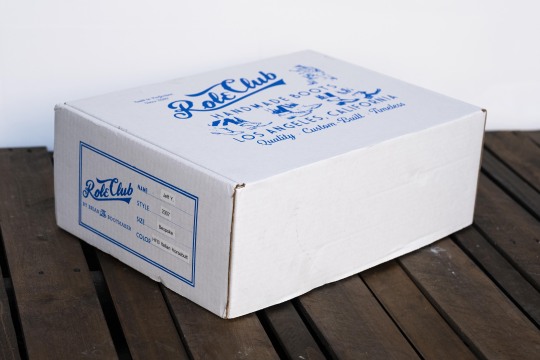

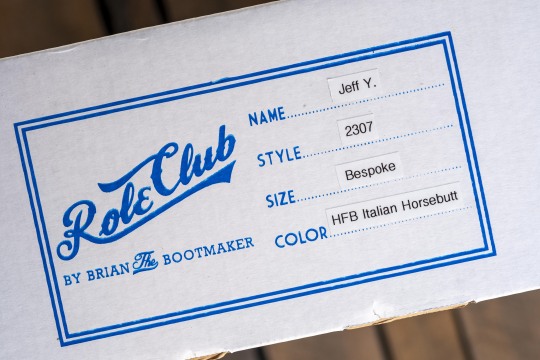
“HFB” for Hand Finished Black.

360 Degree View










The 2307 Last
When trying to pick a last for these engineers, I was debating between his 1940s last and the 2307 last. Ultimately I picked the 2307, mostly because it had a lower toe bump. I do think that his 1940s last is his most popular for engineers, and the toe bump really doesn’t make too big of a difference once the unstructured toe collapses. (For a more in-depth summary of all the lasts/toe shapes Role Club toe has available, I will link you to Brian’s YouTube video.)

Profile views of both the 1940 and 2307 lasts. Notice the more pronounced toe bump on the 1940 last in comparison to the 2307.

I had my Underdogs built on Brian’s 100 last, which typically has a significantly slimmer, almond toe shape in comparison to the 2307 last. However, due to my awkwardly wide feet and bunions, the MTM 100 last ended up not being too dissimilar from my MTM 2307 last. I definitely like the 2307 more, as the outer sweep of the toe box has a more angular, elegant curve in comparison to my 100 last, which kinda just looks like a thumb.

As you can see, my Underdogs were supposedly built on the 100 last, but ended up being way more rounded than expected (which I’m happy about).
The Leather

Brian most often sources his leather from the Horween Tannery, specifically CXL horsehide and shell cordovan. Brian used brown CXL horsehide hand-finished black for his own pair of engineer boots, which has aged incredibly. Personally, I tend to opt for vegtan leathers whenever possible, as it’s more environmentally friendly and in my opinion tends to build a nicer patina than chrome tanned or combination tanned leathers. Luckily, Brian happened to have some brown Italian horsebutt lying around his shop that he was willing to offer me. At the time, Brian didn’t remember the tannery from which he sourced the horsebutt (which, according to him, no longer exists), but he was able to send me a few photos. I immediately said yes.

A few photos of another pair of engineers Brian made in the same Italian brown horsebutt. Loved the depth of color...which I had painted over. lol

I was hesitant at first to have Brian hand-paint black dye over this beautiful brown leather. However, I was pretty set on getting some classic black engineers, and I trusted that the black dye would slowly fade away in high abrasion areas, resulting in a beautiful black-brown pseudo-tea core finish. For horsebutt leather, there actually isn’t too much visible grain/marbling within the leather). It has a fairly smooth, consistent finish, which I don’t mind at all. Also, I can already see some browns peeking through, which gives me hope as to how the black dye will chip away as these boots break in.

Some of the brown undertones can already be seen beneath the black dye, which is most apparent on the vamps.
The Pattern & Stitching

I absolutely love Brian’s take on engineer boots. His pattern works perfectly with his lasts, creating a very well balanced, properly proportioned boot that looks just as good sitting on a shelf as it does on foot.

To my understanding, all of the boots in the Role Club Collection are branded with the same two markings: an embossed logo on the left boot and a sewn-on tag on the right.

The back stay is simple and clean. No extravagant stitch patterns or anything, just very clean, vertical lines. Nice, conservative, elegant. I like it.



I think of all the engineer boots I’ve seen on Instagram, the buckles Brian uses are some of my favorite. Flat, rectangular, roller buckles. Again, nothing gaudy. Some other brands choose to use more elaborate, bulbous buckles on their engineer boots, which kinda just look out of place. Maybe they’re too eye-catching, making it seem like they’re trying too hard. In contrast, Brian’s simple flat buckles are clean and minimal, allowing the pattern and construction quality of the boots speak for themselves. Less is more.




In general, I tend to like the look of 3-4 rows of stitching as opposed to just two. It just looks more substantial and sturdy. (Does it actually increase the quality or longevity of the boot? Probably not. I just like how it looks.) Also, can we take a moment to appreciate just how absolutely pristine this upper stitching is?

Perhaps my preference for 3-4 rows of stitching stems from my appreciation for higher levels of craftsmanship when it comes to boot pattern and construction. Having additional rows of stitching all perfectly spaced and parallel requires a little more attention to detail, and it looks amazing when properly executed.


2, 3, and 4 rows of stitching, all equally dense, evenly spaced, and perfectly parallel. Perfect execution. I haven’t found a single stitch out of place on the uppers of either boot.
Another little feature I opted to include on my boots were hand-crimped toe tracks running up the vamps of each boot. To be honest, I didn’t know too much about why it’s done or it’s benefits. However, here is an explanation I found on superfuture from Brian himself, posted by @beautiful_FrEaK:
The indentation you see on the boots is called a toe track. The reason a boot has a toe track is because the vamp went through the crimping process. It is used to get all the stretch out of the vamp because when a bootmaker needs to turn something that's 2D into 3D it is more work if the vamp is not crimped. Another benefit when a vamp is crimped is it keeps the vamp smooth without any wrinkles. The crimped vamp sits well on the shoe last.
There are different way to crimp a vamp. For example Buco puts their vamps into a crimp machine. It is a hot blade that folds the vamp in half and indents the leather. I wouldn't mind having a crimp machine (really expensive!) but I use crimp boards at the moment. It is the same process but more hands on. I last the vamp on a piece of board to get all the stretch out and it naturally gets the toe track.
Personally, I mostly chose to have the toe track for esthetic purposes, but understanding the reasoning behind it is pretty cool too.

The Heel

Unlike my Underdog boots, which have a low woodsman heel, I decided to go all out with the full woodsman heel on these engineers. I will admit, walking with such elevated heels will take some getting used to. It also definitely adds to the whole western cowboy boot vibe, but I dig it. Plus, the added lift makes me over 6 feet tall now. Added bonus.


The Sole

This is my first pair of boots with a full leather sole. Felt a bit risky putting it on such an expensive pair of boots, but whatever. They look great on Brian’s pair, so I wasn’t too worried. Plus, I live a pretty sedentary lifestyle in the California Bay Area. I don’t go on many nature hikes, nor does it ever snow here (or rain really, for that matter). Thus, I don’t really have a need for much grip or traction with my footwear.

The sole channel stitching is all pretty clean, minus one little wonky spot on the inside portion of the right boot (pictured above in the top left corner). Not a big deal though, as no one is ever gonna see it.
My biggest concern with full leather soles was the reduced durability/longevity from walking on concrete, specifically at the toe. To combat this, I asked Brian to add metal toe plates to my boots to prevent premature wear at the toe. Crisis averted.

Here’s a close up of one of the toe plates, cut into the leather sole as to be nice and flush. Apparently these had to be custom ordered to accommodate for the width of my foot, adding 4-5 months to my wait time. Meh. Worth the wait in my opinion, if it meant getting it done right.
The Welt Stitching
Similar to my Underdogs, the welt stitching on these engineers is all very clean and consistent. If I were to point out anything, it’d be that a little bit of black edge dye got on the white stitching in some areas, and there’s a small tuft of loose thread ends popping out on the inside of the left boot. However, if these are the biggest errors I could find on the whole boot, I think that’s pretty amazing.




If you look closely, you can see the spots where some of the black edge coat got onto the white welt stitching. Not the cleanest, but doesn’t bother me too much.

Here’s the small tuft of loose threads at the end of one of the 270 degree welt stitches. Again, very minor, and won’t keep me up at night.

Try On & Initial Thoughts

Being completely honest, I’m actually still blown away at how amazing these boots feel on foot. I can really tell that these boots were made to measure. I shouldn’t be surprised though, as the Underdogs Brian made for me last year fit amazingly. Although, being lace-up boots that can by cinched down with laces, they naturally are less prone to fit errors such as heel slip. Engineers, by comparison, are much more difficult to fit properly, but Brian did so masterfully.
First of all, right out of the box I actually had very little trouble getting the boots on and off. I feel like this is often the biggest struggle in breaking in a new pair of engineer boots, but not this time. Sliding my foot down the shaft felt appropriately snug, until my heel snapped past the “pass line” and sucked down into the heel cup. (I actually didn’t even need to unbuckle the strap to get them on, which was double surprising.)

Once fully seated, I could feel the built-in leather-lined orthotics beneath my feet, and the adjusted width of the 2307 last comfortably fit my bunions. What I’m most shocked by is how little heel slip I have in either boot. Until now, I had just assumed that heel slip was to be expected with all engineer boots, and only with break in and wear would that slip maybe go away. Apparently I was wrong, as these engineers already exhibit less heel slip than some of my other boots and derbies.

In designing these engineers, I chose to try out a couple things for the first time: first full leather soles, and first full woodsman heels. I know it’s still early, but I’m already loving the full leather soles. They seem to breathe much more than half and full rubber soles, and they flex and move much more naturally with the movements of my feet. I feel as though I can “feel the ground” better, if that makes sense. I will admit that I can definitely tell these leather soles have significantly less traction than rubber/cork half/full soles. However, I knew that from the get go, so me and my sedentary lifestyle are completely fine with it. I haven’t slipped yet, so it’s all good. Second, the full woodsman heels on these engineers are by far the tallest heels of any boot I own, yet once on foot, I can barely even tell the difference. Even with the steep drop off from the full woodsman heel to the leather sole, walking felt completely natural.

The last thing I’d like to note is how nicely the Italian horsebutt is breaking in. I know it’s still early, but so far all the leather on the vamps and shafts seem to be nice and tight with very little grain break or creasing. Loose grain and unsightly creasing are definitely some of my biggest pet peeves when it comes to boots, so props to Brian on absolutely killing it on the clicking. (At least so far.) I can’t wait to see how this leather continues to break in, and for the black hand-paint to chip away to reveal that beautiful brown horsebutt underneath.

If I had to pick out one spot that may require a little extra break-in, it would be the top rim around the shafts of the boot. They bounce around while I walk, knocking and banging into my shins. I expect this is probably true for most engineer boots, but hopefully this break-in period doesn’t take too long, cuz it doesn’t feel great. Until then, maybe I’ll just have to rock some longer tube socks as shin padding.
(Note: I do my best to remain impartial and objective in all of my reviews. That being said, it was difficult not to sound like some fanboy trying to sell you on a pair of Role Clubs, but this really my honest opinion. I really just love these boots. Lol)
Conclusion
If you couldn’t tell already, I’m absolutely through the roof with regards to these new engineers. The construction quality and level of finishing are pristine, and the comfort and fit out of the box is surprisingly on point. In my opinion, I think Brian and Clinch design two of the most beautiful engineer boots (on Instagram, at least), yet at the same time they exhibit two totally different vibes. Brian’s engineers draw from more rugged, western, cowboy influences, while Clinch engineers are a bit more refined, fitting very nicely within the whole Japanese workwear esthetic. Both styles are very cool, with some of the highest quality construction available.

A comparison of Role Club (top) and Clinch (bottom) engineers, both new and worn. (Photo credit: top left: me, top right: @brianthebootmaker, bottom left: @bsw_keisuke, bottom right: @partial2vintage.)
While I’ve barely owned these for a week, and already I can confidently say that these are one of my favorite pairs in my collection. With such a beautiful pattern and solid construction, I could pick them up and stare at them all day. Also, not gonna lie, the fact that Role Clubs are so difficult to come by these days does make me feel even cooler for owning a pair. Haha

Anyway, I’ll try to write a follow up review once these are more broken in. Until then, you can follow along my journey breaking in these engineers through my instagram (@thedenimdentist). Ttfn!
5 notes
·
View notes
Text
Come One, Come All! The MozCon Virtual 2021 Day One Recap
Our favorite time of the year is here! The second ever MozCon Virtual kicked off yesterday with attendees from over 35 countries. There were networking rooms, photo booth pics, and live tweets. It almost felt like we were back together in one place (just minus the donuts).
Lack of donuts aside, everyone was super excited to be back at MozCon for another action-packed conference. Day one’s speakers brought their A-game and really got people thinking.
Already had several 🤯 moments at #MozCon and it’s only Day 1! Can’t wait for tomorrow. Cheers!
�� Kavi Kardos (@therarevos) July 12, 2021
For those of you who may have missed it, or those of you who had a hard time keeping up with this three ring circus, here's a quick recap!
Sarah Bird — Welcome to MozCon
Moz's fearless leader started MozCon Virtual off with a bang! She introduced Moz Group, a result of the merger with J2. Then, she announced two product releases — one in alpha and one in beta! Both will be further explained by Mozzers later in the week.
A big announcement during the opening session at #MozCon today: "The Moz Group" is now a collection of brands and technologies for digital marketers: pic.twitter.com/F62glc6b89
— Rob Ousbey (@RobOusbey) July 12, 2021
Sarah’s introduction concluded with a moving tribute to Russ Jones. You can share your own memories with Russ or donate to his family at RememberingRussJones.com.
Shannon McGuirk — Lessons in Surviving the Covid News Agenda & What it Means for the Future of Digital PR
As always, Shannon started out strong with some radical transparency. She walked us through Aira’s journey through COVID and how it changed everything.
I have so much love for @ShannonMcGuirk_'s raw honesty #MozCon 💙 pic.twitter.com/lxo08YJS4K
— Areej AbuAli (@areej_abuali) July 12, 2021
In past MozCon presentations, Shannon has shown us the outreach strategies that Aira has depended on for several years, but 2020 threw everyone for a loop. In the first two weeks of lockdown, Aira lost 50% of their revenue. Something had to change.
Actually, everything had to change.
We got insight into Aira’s three-prong, PR future-proofing system that developed as a result:
Ideation: using the ROR framework of relevancy, opinion, resolution
Production: create proven frameworks that can be customized for your client
Promotion: through accessing, communicating, and having perspective
Shannon gave us the nitty gritty of how this system works for Aira, complete with actual photos of their best-performing, always-ready frameworks. Honestly, it felt like we were seeing something confidential, but we were here for it.
Um, I think @ShannonMcGuirk_ is sharing some *serious* @Ariadigital secrets here... They have templates for production that are wireframed and customizable. They run TONS of campaigns off of THREE main templates.#MozConpic.twitter.com/6PcZ3lIlee
— Brie E Anderson (@brie_e_anderson) July 12, 2021
Flavilla Fongang — The Science of Purchasing Behavior: How to Use it Effectively to Attract & Convert More Prospects Into Customers
Flavilla was ready to prescribe some tactical medicine to those looking to increase their conversion rate. She jumped right in with explaining how our brains function. Ya know, limbic system, neocortex, and reptilian brain? Don’t worry, we didn’t either!
She broke them down as the emotional brain (limbic), rational (neocortex), and fight or flight (reptilian). Then Flavilla asked the big question: which brain has the most impact on buying decisions? The answer (which shocked most) was the reptilian brain.
Flavilla took us through six ways the reptilian brain can be stimulated.
Killer slide from @FlavillaFongang#mozconpic.twitter.com/6N5OC5jlOz
— Noah Learner (He/Him) (@noahlearner) July 12, 2021
But it wouldn’t be a MozCon presentation without something that can be put into action today. Flavilla dropped all sorts of tactics to test: putting the CTA closer to the consumer’s picture, using the power of the gaze, tapping into negative emotion, showing contrast (think before and after), and putting the most important information first.
We could have listened to Flavilla talk all day long. Hearing her take on buyer behavior was a bit like looking into a glass ball and getting answers to all of our questions. We can’t wait to put it into action!
Dr. Pete Meyers — Rule Your Rivals: From Data to Action
Always a crowd pleaser, Dr. Pete showed off a new Moz tool currently in Beta: True Competitor. True Competitor is a project Moz has been working on for the last few years, and this year it’s finally ready to take the stage! (You can request early access to True Competitor here.)
Dr. Pete used the new tool to remind us that those we assume to be our competitors sometimes aren’t actually our competition at all. Instead of focusing on who we think we’re losing traffic to, we need to be focused on who is preventing us from making money.
There's a big difference between who you "think" your competition is and who you compete with in the SERPs. #MozCon
— Jason Dodge (@dodgejd) July 12, 2021
Using the new True Competitor tool, and a few cool search modifiers, Dr. Pete was able to find some opportunity keywords to test out.
The process looked a bit like this:
Use True Competitor to identify potential keywords
Use search modifiers to find the ranking pages for the competition
Find Moz’s current ranking content
Create content using the similar keywords
Link to the most updated and relevant content
Get Keywords, competitor pages, and my best piece of content to compete with: @dr_pete#mozconpic.twitter.com/VFk5beIbvI
— Noah Learner (He/Him) (@noahlearner) July 12, 2021
We knew that Dr. Pete would bring the heat, but it’s safe to say he outdid himself this year.
Great talk by @dr_pete from the #mozcon. Take aways: Don't make assumptions about your competitors Do not make a massive novel - come up with a plan including what is missing from your site content issues. Track what works/what doesn't and amend accordingly. @Mozpic.twitter.com/pnUWqeL2vX
— J Turnbull (@SEOJoBlogs) July 12, 2021
Noah Learner — Game-Changing Ways to Use the Google Search Console API
This first-time MozCon speaker came ready to play! Right away, Noah gave us some perspective on the actual limitations of Google Search Console. As most of us know, Search Console only gives you access to 1,000 rows. Well, Noah knew that there was a lot more data to be seen and started dabbling with the API.
Apparently this led to a 15-hour journey down the GSC rabbit hole, as Noah started working on creating a custom Google Search Console tool using Big Query and Google Data Studio. This tool, Explorer for Search, has already gotten some buzz from those in the industry.
If you haven't seen Search Explorer from @noahlearner and Two Octobers you're missing out. Native GSC is abysmal in comparison. #MozCon
— Taylor Murchison (@TaylorMurchison) July 12, 2021
Honestly, if you look at the Twitter feed for #MozCon, there aren’t a ton of tweets because nobody could keep up with him! Noah moved rapidly through exactly how he built Explorer for Search with his team, and how they’re using it.
Loving this striking distance report @noahlearner is showing off #Mozconpic.twitter.com/VgUa1CeAcC
— Jordan Choo (@JordanChoo) July 12, 2021
Almost instantly, Noah and his team found over $300,000 of keywords that weren’t available in Search Console. They did this through building in position sorting, top of funnel/ bottom of funnel sorting, branded vs. non branded filters, and more.
We cannot wait to play with this and get started with the Search Console API!
Dana DiTomaso — Build for Search: Modern Web Dev That Puts SEO First
A long time MozCon favorite, Dana DiTomaso put on her coach’s hat for this year’s session. Far too often, we find ourselves in awkward situations that require us to scrap all of our work and start over again.
“Developers [also] come in way too late […] and come in and say, “oh, I can’t do that” […] or “this isn’t going to work on mobile,” and now you have to start the design all over again. @danaditomaso#MozCon
— Melina Beeston (@mkbeesto) July 12, 2021
Dana ran into this way too many times, so she and her team came up with a better solution. She was ready to make us, and our web dev processes, agile(ish).
She showed us her team's entire process from presenting keyword research (IN A PIE CHART?!), to using GatherContent to create a website blueprint for clients, all the way to wireframe creation and presentation.
SEO projects shouldn't be done in silos. SEO, UX, Design, Dev, & Content teams should all be involved early and often(as needed). The Agile project management method is a great framework that makes this easy to do. Insights from @danaditomaso 's talk #mozconpic.twitter.com/Fl5B8ncSG0
— Ọla King (@justolaking) July 12, 2021
At each step, anyone can jump in and see what is going on and add to the conversation or process. It’s far less linear and allows for more collaboration.
Jackie Chu — Internationalization Errors: How to Go Global Without Losing All of Your Traffic
With a track record like Jackie’s, it’s hard to imagine not blowing minds. Jackie started by explaining one of the most complex SEO concepts: Hreflang. This explanation led to a few tactical suggestions right off of the bat:
Define target language and country
Self-canonicalize all URLs
Use consistent URL patterns
Honestly, there were so many takeaways from this presentation that they were hard to keep track of. Imagine, all of that information on Hreflang alone was in the first 17 slides… and this presentation was 60 slides long!
Great tip by @jackiecchu about using extra signals beyond hreflang to show Google which version of your site is targeted to which international audience, such as linking to that country's respective social profiles, or editing the NAP to reflect that country's info.#mozconpic.twitter.com/2T24euwRyZ
— Lily Ray 😏 (@lilyraynyc) July 12, 2021
You’ll definitely want to revisit this presentation in the video bundle, available Friday, to glean all insights possible!
Cyrus Shepard — Mastering 3 Click + Engagement Signals for Higher Rankings/Traffic
Cyrus, a long-time MozCon emcee, takes the stage himself this year to discuss how Google may — or may not — use user engagement signals as an input in ranking websites.
Cyrus started by explaining how 20 years of Google patents describe three different types of click signals they could measure: first clicks, long clicks, and last clicks. He then walked through a multitude of small-scale SEO experiments that attempted to influence these click signals to see if he could influence rankings.
Some of the experiments included:
Optimizing Meta Descriptions in non-traditional ways
Removing Title Tag "Boilerplate"
Improving the visibility of "Related Articles"
Adding FAQs
Don't do it. For the love of God. Don't do it.#[email protected]/hWxCxLlpju
— Brie E Anderson (@brie_e_anderson) July 12, 2021
Finally, Cyrus shared some case studies including the migration of the Moz Q&A — which involved over 100,000 URLs — and how they improved user engagement.
What a great URL path migration process and conduction from @Moz's SEO team! Moving the Q&A section with some important checklist is something, but also, when it comes to user-generated content, it's hard to change. So @CyrusShepard came with over 16% success after that. #MozConpic.twitter.com/bIHk8uVHA6
— Roman Adamita (@AdamitaRoman) July 12, 2021
At the end, Cyrus emphasized that SEO is not about manipulating numbers, but that "User satisfaction is ranking factor #1." After watching this presentation, you'll definitely walk away with several ideas for engaging your visitor.
1 note
·
View note
Text
Come One, Come All! The MozCon Virtual 2021 Day One Recap
Our favorite time of the year is here! The second ever MozCon Virtual kicked off yesterday with attendees from over 35 countries. There were networking rooms, photo booth pics, and live tweets. It almost felt like we were back together in one place (just minus the donuts).
Lack of donuts aside, everyone was super excited to be back at MozCon for another action-packed conference. Day one’s speakers brought their A-game and really got people thinking.
Already had several 🤯 moments at #MozCon and it’s only Day 1! Can’t wait for tomorrow. Cheers!
— Kavi Kardos (@therarevos) July 12, 2021
For those of you who may have missed it, or those of you who had a hard time keeping up with this three ring circus, here's a quick recap!
Sarah Bird — Welcome to MozCon
Moz's fearless leader started MozCon Virtual off with a bang! She introduced Moz Group, a result of the merger with J2. Then, she announced two product releases — one in alpha and one in beta! Both will be further explained by Mozzers later in the week.
A big announcement during the opening session at #MozCon today: "The Moz Group" is now a collection of brands and technologies for digital marketers: pic.twitter.com/F62glc6b89
— Rob Ousbey (@RobOusbey) July 12, 2021
Sarah’s introduction concluded with a moving tribute to Russ Jones. You can share your own memories with Russ or donate to his family at RememberingRussJones.com.
Shannon McGuirk — Lessons in Surviving the Covid News Agenda & What it Means for the Future of Digital PR
As always, Shannon started out strong with some radical transparency. She walked us through Aira’s journey through COVID and how it changed everything.
I have so much love for @ShannonMcGuirk_'s raw honesty #MozCon 💙 pic.twitter.com/lxo08YJS4K
— Areej AbuAli (@areej_abuali) July 12, 2021
In past MozCon presentations, Shannon has shown us the outreach strategies that Aira has depended on for several years, but 2020 threw everyone for a loop. In the first two weeks of lockdown, Aira lost 50% of their revenue. Something had to change.
Actually, everything had to change.
We got insight into Aira’s three-prong, PR future-proofing system that developed as a result:
Ideation: using the ROR framework of relevancy, opinion, resolution
Production: create proven frameworks that can be customized for your client
Promotion: through accessing, communicating, and having perspective
Shannon gave us the nitty gritty of how this system works for Aira, complete with actual photos of their best-performing, always-ready frameworks. Honestly, it felt like we were seeing something confidential, but we were here for it.
Um, I think @ShannonMcGuirk_ is sharing some *serious* @Ariadigital secrets here... They have templates for production that are wireframed and customizable. They run TONS of campaigns off of THREE main templates.#MozConpic.twitter.com/6PcZ3lIlee
— Brie E Anderson (@brie_e_anderson) July 12, 2021
Flavilla Fongang — The Science of Purchasing Behavior: How to Use it Effectively to Attract & Convert More Prospects Into Customers
Flavilla was ready to prescribe some tactical medicine to those looking to increase their conversion rate. She jumped right in with explaining how our brains function. Ya know, limbic system, neocortex, and reptilian brain? Don’t worry, we didn’t either!
She broke them down as the emotional brain (limbic), rational (neocortex), and fight or flight (reptilian). Then Flavilla asked the big question: which brain has the most impact on buying decisions? The answer (which shocked most) was the reptilian brain.
Flavilla took us through six ways the reptilian brain can be stimulated.
Killer slide from @FlavillaFongang#mozconpic.twitter.com/6N5OC5jlOz
— Noah Learner (He/Him) (@noahlearner) July 12, 2021
But it wouldn’t be a MozCon presentation without something that can be put into action today. Flavilla dropped all sorts of tactics to test: putting the CTA closer to the consumer’s picture, using the power of the gaze, tapping into negative emotion, showing contrast (think before and after), and putting the most important information first.
We could have listened to Flavilla talk all day long. Hearing her take on buyer behavior was a bit like looking into a glass ball and getting answers to all of our questions. We can’t wait to put it into action!
Dr. Pete Meyers — Rule Your Rivals: From Data to Action
Always a crowd pleaser, Dr. Pete showed off a new Moz tool currently in Beta: True Competitor. True Competitor is a project Moz has been working on for the last few years, and this year it’s finally ready to take the stage! (You can request early access to True Competitor here.)
Dr. Pete used the new tool to remind us that those we assume to be our competitors sometimes aren’t actually our competition at all. Instead of focusing on who we think we’re losing traffic to, we need to be focused on who is preventing us from making money.
There's a big difference between who you "think" your competition is and who you compete with in the SERPs. #MozCon
— Jason Dodge (@dodgejd) July 12, 2021
Using the new True Competitor tool, and a few cool search modifiers, Dr. Pete was able to find some opportunity keywords to test out.
The process looked a bit like this:
Use True Competitor to identify potential keywords
Use search modifiers to find the ranking pages for the competition
Find Moz’s current ranking content
Create content using the similar keywords
Link to the most updated and relevant content
Get Keywords, competitor pages, and my best piece of content to compete with: @dr_pete#mozconpic.twitter.com/VFk5beIbvI
— Noah Learner (He/Him) (@noahlearner) July 12, 2021
We knew that Dr. Pete would bring the heat, but it’s safe to say he outdid himself this year.
Great talk by @dr_pete from the #mozcon. Take aways: Don't make assumptions about your competitors Do not make a massive novel - come up with a plan including what is missing from your site content issues. Track what works/what doesn't and amend accordingly. @Mozpic.twitter.com/pnUWqeL2vX
— J Turnbull (@SEOJoBlogs) July 12, 2021
Noah Learner — Game-Changing Ways to Use the Google Search Console API
This first-time MozCon speaker came ready to play! Right away, Noah gave us some perspective on the actual limitations of Google Search Console. As most of us know, Search Console only gives you access to 1,000 rows. Well, Noah knew that there was a lot more data to be seen and started dabbling with the API.
Apparently this led to a 15-hour journey down the GSC rabbit hole, as Noah started working on creating a custom Google Search Console tool using Big Query and Google Data Studio. This tool, Explorer for Search, has already gotten some buzz from those in the industry.
If you haven't seen Search Explorer from @noahlearner and Two Octobers you're missing out. Native GSC is abysmal in comparison. #MozCon
— Taylor Murchison (@TaylorMurchison) July 12, 2021
Honestly, if you look at the Twitter feed for #MozCon, there aren’t a ton of tweets because nobody could keep up with him! Noah moved rapidly through exactly how he built Explorer for Search with his team, and how they’re using it.
Loving this striking distance report @noahlearner is showing off #Mozconpic.twitter.com/VgUa1CeAcC
— Jordan Choo (@JordanChoo) July 12, 2021
Almost instantly, Noah and his team found over $300,000 of keywords that weren’t available in Search Console. They did this through building in position sorting, top of funnel/ bottom of funnel sorting, branded vs. non branded filters, and more.
We cannot wait to play with this and get started with the Search Console API!
Dana DiTomaso — Build for Search: Modern Web Dev That Puts SEO First
A long time MozCon favorite, Dana DiTomaso put on her coach’s hat for this year’s session. Far too often, we find ourselves in awkward situations that require us to scrap all of our work and start over again.
“Developers [also] come in way too late […] and come in and say, “oh, I can’t do that” […] or “this isn’t going to work on mobile,” and now you have to start the design all over again. @danaditomaso#MozCon
— Melina Beeston (@mkbeesto) July 12, 2021
Dana ran into this way too many times, so she and her team came up with a better solution. She was ready to make us, and our web dev processes, agile(ish).
She showed us her team's entire process from presenting keyword research (IN A PIE CHART?!), to using GatherContent to create a website blueprint for clients, all the way to wireframe creation and presentation.
SEO projects shouldn't be done in silos. SEO, UX, Design, Dev, & Content teams should all be involved early and often(as needed). The Agile project management method is a great framework that makes this easy to do. Insights from @danaditomaso 's talk #mozconpic.twitter.com/Fl5B8ncSG0
— Ọla King (@justolaking) July 12, 2021
At each step, anyone can jump in and see what is going on and add to the conversation or process. It’s far less linear and allows for more collaboration.
Jackie Chu — Internationalization Errors: How to Go Global Without Losing All of Your Traffic
With a track record like Jackie’s, it’s hard to imagine not blowing minds. Jackie started by explaining one of the most complex SEO concepts: Hreflang. This explanation led to a few tactical suggestions right off of the bat:
Define target language and country
Self-canonicalize all URLs
Use consistent URL patterns
Honestly, there were so many takeaways from this presentation that they were hard to keep track of. Imagine, all of that information on Hreflang alone was in the first 17 slides… and this presentation was 60 slides long!
Great tip by @jackiecchu about using extra signals beyond hreflang to show Google which version of your site is targeted to which international audience, such as linking to that country's respective social profiles, or editing the NAP to reflect that country's info.#mozconpic.twitter.com/2T24euwRyZ
— Lily Ray 😏 (@lilyraynyc) July 12, 2021
You’ll definitely want to revisit this presentation in the video bundle, available Friday, to glean all insights possible!
Cyrus Shepard — Mastering 3 Click + Engagement Signals for Higher Rankings/Traffic
Cyrus, a long-time MozCon emcee, takes the stage himself this year to discuss how Google may — or may not — use user engagement signals as an input in ranking websites.
Cyrus started by explaining how 20 years of Google patents describe three different types of click signals they could measure: first clicks, long clicks, and last clicks. He then walked through a multitude of small-scale SEO experiments that attempted to influence these click signals to see if he could influence rankings.
Some of the experiments included:
Optimizing Meta Descriptions in non-traditional ways
Removing Title Tag "Boilerplate"
Improving the visibility of "Related Articles"
Adding FAQs
Don't do it. For the love of God. Don't do it.#[email protected]/hWxCxLlpju
— Brie E Anderson (@brie_e_anderson) July 12, 2021
Finally, Cyrus shared some case studies including the migration of the Moz Q&A — which involved over 100,000 URLs — and how they improved user engagement.
What a great URL path migration process and conduction from @Moz's SEO team! Moving the Q&A section with some important checklist is something, but also, when it comes to user-generated content, it's hard to change. So @CyrusShepard came with over 16% success after that. #MozConpic.twitter.com/bIHk8uVHA6
— Roman Adamita (@AdamitaRoman) July 12, 2021
At the end, Cyrus emphasized that SEO is not about manipulating numbers, but that "User satisfaction is ranking factor #1." After watching this presentation, you'll definitely walk away with several ideas for engaging your visitor.
0 notes
Text
Come One, Come All! The MozCon Virtual 2021 Day One Recap
Our favorite time of the year is here! The second ever MozCon Virtual kicked off yesterday with attendees from over 35 countries. There were networking rooms, photo booth pics, and live tweets. It almost felt like we were back together in one place (just minus the donuts).
Lack of donuts aside, everyone was super excited to be back at MozCon for another action-packed conference. Day one’s speakers brought their A-game and really got people thinking.
Already had several 🤯 moments at #MozCon and it’s only Day 1! Can’t wait for tomorrow. Cheers!
— Kavi Kardos (@therarevos) July 12, 2021
For those of you who may have missed it, or those of you who had a hard time keeping up with this three ring circus, here's a quick recap!
Sarah Bird — Welcome to MozCon
Moz's fearless leader started MozCon Virtual off with a bang! She introduced Moz Group, a result of the merger with J2. Then, she announced two product releases — one in alpha and one in beta! Both will be further explained by Mozzers later in the week.
A big announcement during the opening session at #MozCon today: "The Moz Group" is now a collection of brands and technologies for digital marketers: pic.twitter.com/F62glc6b89
— Rob Ousbey (@RobOusbey) July 12, 2021
Sarah’s introduction concluded with a moving tribute to Russ Jones. You can share your own memories with Russ or donate to his family at RememberingRussJones.com.
Shannon McGuirk — Lessons in Surviving the Covid News Agenda & What it Means for the Future of Digital PR
As always, Shannon started out strong with some radical transparency. She walked us through Aira’s journey through COVID and how it changed everything.
I have so much love for @ShannonMcGuirk_'s raw honesty #MozCon 💙 pic.twitter.com/lxo08YJS4K
— Areej AbuAli (@areej_abuali) July 12, 2021
In past MozCon presentations, Shannon has shown us the outreach strategies that Aira has depended on for several years, but 2020 threw everyone for a loop. In the first two weeks of lockdown, Aira lost 50% of their revenue. Something had to change.
Actually, everything had to change.
We got insight into Aira’s three-prong, PR future-proofing system that developed as a result:
Ideation: using the ROR framework of relevancy, opinion, resolution
Production: create proven frameworks that can be customized for your client
Promotion: through accessing, communicating, and having perspective
Shannon gave us the nitty gritty of how this system works for Aira, complete with actual photos of their best-performing, always-ready frameworks. Honestly, it felt like we were seeing something confidential, but we were here for it.
Um, I think @ShannonMcGuirk_ is sharing some *serious* @Ariadigital secrets here... They have templates for production that are wireframed and customizable. They run TONS of campaigns off of THREE main templates.#MozConpic.twitter.com/6PcZ3lIlee
— Brie E Anderson (@brie_e_anderson) July 12, 2021
Flavilla Fongang — The Science of Purchasing Behavior: How to Use it Effectively to Attract & Convert More Prospects Into Customers
Flavilla was ready to prescribe some tactical medicine to those looking to increase their conversion rate. She jumped right in with explaining how our brains function. Ya know, limbic system, neocortex, and reptilian brain? Don’t worry, we didn’t either!
She broke them down as the emotional brain (limbic), rational (neocortex), and fight or flight (reptilian). Then Flavilla asked the big question: which brain has the most impact on buying decisions? The answer (which shocked most) was the reptilian brain.
Flavilla took us through six ways the reptilian brain can be stimulated.
Killer slide from @FlavillaFongang#mozconpic.twitter.com/6N5OC5jlOz
— Noah Learner (He/Him) (@noahlearner) July 12, 2021
But it wouldn’t be a MozCon presentation without something that can be put into action today. Flavilla dropped all sorts of tactics to test: putting the CTA closer to the consumer’s picture, using the power of the gaze, tapping into negative emotion, showing contrast (think before and after), and putting the most important information first.
We could have listened to Flavilla talk all day long. Hearing her take on buyer behavior was a bit like looking into a glass ball and getting answers to all of our questions. We can’t wait to put it into action!
Dr. Pete Meyers — Rule Your Rivals: From Data to Action
Always a crowd pleaser, Dr. Pete showed off a new Moz tool currently in Beta: True Competitor. True Competitor is a project Moz has been working on for the last few years, and this year it’s finally ready to take the stage! (You can request early access to True Competitor here.)
Dr. Pete used the new tool to remind us that those we assume to be our competitors sometimes aren’t actually our competition at all. Instead of focusing on who we think we’re losing traffic to, we need to be focused on who is preventing us from making money.
There's a big difference between who you "think" your competition is and who you compete with in the SERPs. #MozCon
— Jason Dodge (@dodgejd) July 12, 2021
Using the new True Competitor tool, and a few cool search modifiers, Dr. Pete was able to find some opportunity keywords to test out.
The process looked a bit like this:
Use True Competitor to identify potential keywords
Use search modifiers to find the ranking pages for the competition
Find Moz’s current ranking content
Create content using the similar keywords
Link to the most updated and relevant content
Get Keywords, competitor pages, and my best piece of content to compete with: @dr_pete#mozconpic.twitter.com/VFk5beIbvI
— Noah Learner (He/Him) (@noahlearner) July 12, 2021
We knew that Dr. Pete would bring the heat, but it’s safe to say he outdid himself this year.
Great talk by @dr_pete from the #mozcon. Take aways: Don't make assumptions about your competitors Do not make a massive novel - come up with a plan including what is missing from your site content issues. Track what works/what doesn't and amend accordingly. @Mozpic.twitter.com/pnUWqeL2vX
— J Turnbull (@SEOJoBlogs) July 12, 2021
Noah Learner — Game-Changing Ways to Use the Google Search Console API
This first-time MozCon speaker came ready to play! Right away, Noah gave us some perspective on the actual limitations of Google Search Console. As most of us know, Search Console only gives you access to 1,000 rows. Well, Noah knew that there was a lot more data to be seen and started dabbling with the API.
Apparently this led to a 15-hour journey down the GSC rabbit hole, as Noah started working on creating a custom Google Search Console tool using Big Query and Google Data Studio. This tool, Explorer for Search, has already gotten some buzz from those in the industry.
If you haven't seen Search Explorer from @noahlearner and Two Octobers you're missing out. Native GSC is abysmal in comparison. #MozCon
— Taylor Murchison (@TaylorMurchison) July 12, 2021
Honestly, if you look at the Twitter feed for #MozCon, there aren’t a ton of tweets because nobody could keep up with him! Noah moved rapidly through exactly how he built Explorer for Search with his team, and how they’re using it.
Loving this striking distance report @noahlearner is showing off #Mozconpic.twitter.com/VgUa1CeAcC
— Jordan Choo (@JordanChoo) July 12, 2021
Almost instantly, Noah and his team found over $300,000 of keywords that weren’t available in Search Console. They did this through building in position sorting, top of funnel/ bottom of funnel sorting, branded vs. non branded filters, and more.
We cannot wait to play with this and get started with the Search Console API!
Dana DiTomaso — Build for Search: Modern Web Dev That Puts SEO First
A long time MozCon favorite, Dana DiTomaso put on her coach’s hat for this year’s session. Far too often, we find ourselves in awkward situations that require us to scrap all of our work and start over again.
“Developers [also] come in way too late […] and come in and say, “oh, I can’t do that” […] or “this isn’t going to work on mobile,” and now you have to start the design all over again. @danaditomaso#MozCon
— Melina Beeston (@mkbeesto) July 12, 2021
Dana ran into this way too many times, so she and her team came up with a better solution. She was ready to make us, and our web dev processes, agile(ish).
She showed us her team's entire process from presenting keyword research (IN A PIE CHART?!), to using GatherContent to create a website blueprint for clients, all the way to wireframe creation and presentation.
SEO projects shouldn't be done in silos. SEO, UX, Design, Dev, & Content teams should all be involved early and often(as needed). The Agile project management method is a great framework that makes this easy to do. Insights from @danaditomaso 's talk #mozconpic.twitter.com/Fl5B8ncSG0
— Ọla King (@justolaking) July 12, 2021
At each step, anyone can jump in and see what is going on and add to the conversation or process. It’s far less linear and allows for more collaboration.
Jackie Chu — Internationalization Errors: How to Go Global Without Losing All of Your Traffic
With a track record like Jackie’s, it’s hard to imagine not blowing minds. Jackie started by explaining one of the most complex SEO concepts: Hreflang. This explanation led to a few tactical suggestions right off of the bat:
Define target language and country
Self-canonicalize all URLs
Use consistent URL patterns
Honestly, there were so many takeaways from this presentation that they were hard to keep track of. Imagine, all of that information on Hreflang alone was in the first 17 slides… and this presentation was 60 slides long!
Great tip by @jackiecchu about using extra signals beyond hreflang to show Google which version of your site is targeted to which international audience, such as linking to that country's respective social profiles, or editing the NAP to reflect that country's info.#mozconpic.twitter.com/2T24euwRyZ
— Lily Ray 😏 (@lilyraynyc) July 12, 2021
You’ll definitely want to revisit this presentation in the video bundle, available Friday, to glean all insights possible!
Cyrus Shepard — Mastering 3 Click + Engagement Signals for Higher Rankings/Traffic
Cyrus, a long-time MozCon emcee, takes the stage himself this year to discuss how Google may — or may not — use user engagement signals as an input in ranking websites.
Cyrus started by explaining how 20 years of Google patents describe three different types of click signals they could measure: first clicks, long clicks, and last clicks. He then walked through a multitude of small-scale SEO experiments that attempted to influence these click signals to see if he could influence rankings.
Some of the experiments included:
Optimizing Meta Descriptions in non-traditional ways
Removing Title Tag "Boilerplate"
Improving the visibility of "Related Articles"
Adding FAQs
Don't do it. For the love of God. Don't do it.#[email protected]/hWxCxLlpju
— Brie E Anderson (@brie_e_anderson) July 12, 2021
Finally, Cyrus shared some case studies including the migration of the Moz Q&A — which involved over 100,000 URLs — and how they improved user engagement.
What a great URL path migration process and conduction from @Moz's SEO team! Moving the Q&A section with some important checklist is something, but also, when it comes to user-generated content, it's hard to change. So @CyrusShepard came with over 16% success after that. #MozConpic.twitter.com/bIHk8uVHA6
— Roman Adamita (@AdamitaRoman) July 12, 2021
At the end, Cyrus emphasized that SEO is not about manipulating numbers, but that "User satisfaction is ranking factor #1." After watching this presentation, you'll definitely walk away with several ideas for engaging your visitor.
0 notes
Text
Come One, Come All! The MozCon Virtual 2021 Day One Recap
Our favorite time of the year is here! The second ever MozCon Virtual kicked off yesterday with attendees from over 35 countries. There were networking rooms, photo booth pics, and live tweets. It almost felt like we were back together in one place (just minus the donuts).
Lack of donuts aside, everyone was super excited to be back at MozCon for another action-packed conference. Day one’s speakers brought their A-game and really got people thinking.
Already had several 🤯 moments at #MozCon and it’s only Day 1! Can’t wait for tomorrow. Cheers!
— Kavi Kardos (@therarevos) July 12, 2021
For those of you who may have missed it, or those of you who had a hard time keeping up with this three ring circus, here's a quick recap!
Sarah Bird — Welcome to MozCon
Moz's fearless leader started MozCon Virtual off with a bang! She introduced Moz Group, a result of the merger with J2. Then, she announced two product releases — one in alpha and one in beta! Both will be further explained by Mozzers later in the week.
A big announcement during the opening session at #MozCon today: "The Moz Group" is now a collection of brands and technologies for digital marketers: pic.twitter.com/F62glc6b89
— Rob Ousbey (@RobOusbey) July 12, 2021
Sarah’s introduction concluded with a moving tribute to Russ Jones. You can share your own memories with Russ or donate to his family at RememberingRussJones.com.
Shannon McGuirk — Lessons in Surviving the Covid News Agenda & What it Means for the Future of Digital PR
As always, Shannon started out strong with some radical transparency. She walked us through Aira’s journey through COVID and how it changed everything.
I have so much love for @ShannonMcGuirk_'s raw honesty #MozCon 💙 pic.twitter.com/lxo08YJS4K
— Areej AbuAli (@areej_abuali) July 12, 2021
In past MozCon presentations, Shannon has shown us the outreach strategies that Aira has depended on for several years, but 2020 threw everyone for a loop. In the first two weeks of lockdown, Aira lost 50% of their revenue. Something had to change.
Actually, everything had to change.
We got insight into Aira’s three-prong, PR future-proofing system that developed as a result:
Ideation: using the ROR framework of relevancy, opinion, resolution
Production: create proven frameworks that can be customized for your client
Promotion: through accessing, communicating, and having perspective
Shannon gave us the nitty gritty of how this system works for Aira, complete with actual photos of their best-performing, always-ready frameworks. Honestly, it felt like we were seeing something confidential, but we were here for it.
Um, I think @ShannonMcGuirk_ is sharing some *serious* @Ariadigital secrets here... They have templates for production that are wireframed and customizable. They run TONS of campaigns off of THREE main templates.#MozConpic.twitter.com/6PcZ3lIlee
— Brie E Anderson (@brie_e_anderson) July 12, 2021
Flavilla Fongang — The Science of Purchasing Behavior: How to Use it Effectively to Attract & Convert More Prospects Into Customers
Flavilla was ready to prescribe some tactical medicine to those looking to increase their conversion rate. She jumped right in with explaining how our brains function. Ya know, limbic system, neocortex, and reptilian brain? Don’t worry, we didn’t either!
She broke them down as the emotional brain (limbic), rational (neocortex), and fight or flight (reptilian). Then Flavilla asked the big question: which brain has the most impact on buying decisions? The answer (which shocked most) was the reptilian brain.
Flavilla took us through six ways the reptilian brain can be stimulated.
Killer slide from @FlavillaFongang#mozconpic.twitter.com/6N5OC5jlOz
— Noah Learner (He/Him) (@noahlearner) July 12, 2021
But it wouldn’t be a MozCon presentation without something that can be put into action today. Flavilla dropped all sorts of tactics to test: putting the CTA closer to the consumer’s picture, using the power of the gaze, tapping into negative emotion, showing contrast (think before and after), and putting the most important information first.
We could have listened to Flavilla talk all day long. Hearing her take on buyer behavior was a bit like looking into a glass ball and getting answers to all of our questions. We can’t wait to put it into action!
Dr. Pete Meyers — Rule Your Rivals: From Data to Action
Always a crowd pleaser, Dr. Pete showed off a new Moz tool currently in Beta: True Competitor. True Competitor is a project Moz has been working on for the last few years, and this year it’s finally ready to take the stage! (You can request early access to True Competitor here.)
Dr. Pete used the new tool to remind us that those we assume to be our competitors sometimes aren’t actually our competition at all. Instead of focusing on who we think we’re losing traffic to, we need to be focused on who is preventing us from making money.
There's a big difference between who you "think" your competition is and who you compete with in the SERPs. #MozCon
— Jason Dodge (@dodgejd) July 12, 2021
Using the new True Competitor tool, and a few cool search modifiers, Dr. Pete was able to find some opportunity keywords to test out.
The process looked a bit like this:
Use True Competitor to identify potential keywords
Use search modifiers to find the ranking pages for the competition
Find Moz’s current ranking content
Create content using the similar keywords
Link to the most updated and relevant content
Get Keywords, competitor pages, and my best piece of content to compete with: @dr_pete#mozconpic.twitter.com/VFk5beIbvI
— Noah Learner (He/Him) (@noahlearner) July 12, 2021
We knew that Dr. Pete would bring the heat, but it’s safe to say he outdid himself this year.
Great talk by @dr_pete from the #mozcon. Take aways: Don't make assumptions about your competitors Do not make a massive novel - come up with a plan including what is missing from your site content issues. Track what works/what doesn't and amend accordingly. @Mozpic.twitter.com/pnUWqeL2vX
— J Turnbull (@SEOJoBlogs) July 12, 2021
Noah Learner — Game-Changing Ways to Use the Google Search Console API
This first-time MozCon speaker came ready to play! Right away, Noah gave us some perspective on the actual limitations of Google Search Console. As most of us know, Search Console only gives you access to 1,000 rows. Well, Noah knew that there was a lot more data to be seen and started dabbling with the API.
Apparently this led to a 15-hour journey down the GSC rabbit hole, as Noah started working on creating a custom Google Search Console tool using Big Query and Google Data Studio. This tool, Explorer for Search, has already gotten some buzz from those in the industry.
If you haven't seen Search Explorer from @noahlearner and Two Octobers you're missing out. Native GSC is abysmal in comparison. #MozCon
— Taylor Murchison (@TaylorMurchison) July 12, 2021
Honestly, if you look at the Twitter feed for #MozCon, there aren’t a ton of tweets because nobody could keep up with him! Noah moved rapidly through exactly how he built Explorer for Search with his team, and how they’re using it.
Loving this striking distance report @noahlearner is showing off #Mozconpic.twitter.com/VgUa1CeAcC
— Jordan Choo (@JordanChoo) July 12, 2021
Almost instantly, Noah and his team found over $300,000 of keywords that weren’t available in Search Console. They did this through building in position sorting, top of funnel/ bottom of funnel sorting, branded vs. non branded filters, and more.
We cannot wait to play with this and get started with the Search Console API!
Dana DiTomaso — Build for Search: Modern Web Dev That Puts SEO First
A long time MozCon favorite, Dana DiTomaso put on her coach’s hat for this year’s session. Far too often, we find ourselves in awkward situations that require us to scrap all of our work and start over again.
“Developers [also] come in way too late […] and come in and say, “oh, I can’t do that” […] or “this isn’t going to work on mobile,” and now you have to start the design all over again. @danaditomaso#MozCon
— Melina Beeston (@mkbeesto) July 12, 2021
Dana ran into this way too many times, so she and her team came up with a better solution. She was ready to make us, and our web dev processes, agile(ish).
She showed us her team's entire process from presenting keyword research (IN A PIE CHART?!), to using GatherContent to create a website blueprint for clients, all the way to wireframe creation and presentation.
SEO projects shouldn't be done in silos. SEO, UX, Design, Dev, & Content teams should all be involved early and often(as needed). The Agile project management method is a great framework that makes this easy to do. Insights from @danaditomaso 's talk #mozconpic.twitter.com/Fl5B8ncSG0
— Ọla King (@justolaking) July 12, 2021
At each step, anyone can jump in and see what is going on and add to the conversation or process. It’s far less linear and allows for more collaboration.
Jackie Chu — Internationalization Errors: How to Go Global Without Losing All of Your Traffic
With a track record like Jackie’s, it’s hard to imagine not blowing minds. Jackie started by explaining one of the most complex SEO concepts: Hreflang. This explanation led to a few tactical suggestions right off of the bat:
Define target language and country
Self-canonicalize all URLs
Use consistent URL patterns
Honestly, there were so many takeaways from this presentation that they were hard to keep track of. Imagine, all of that information on Hreflang alone was in the first 17 slides… and this presentation was 60 slides long!
Great tip by @jackiecchu about using extra signals beyond hreflang to show Google which version of your site is targeted to which international audience, such as linking to that country's respective social profiles, or editing the NAP to reflect that country's info.#mozconpic.twitter.com/2T24euwRyZ
— Lily Ray 😏 (@lilyraynyc) July 12, 2021
You’ll definitely want to revisit this presentation in the video bundle, available Friday, to glean all insights possible!
Cyrus Shepard — Mastering 3 Click + Engagement Signals for Higher Rankings/Traffic
Cyrus, a long-time MozCon emcee, takes the stage himself this year to discuss how Google may — or may not — use user engagement signals as an input in ranking websites.
Cyrus started by explaining how 20 years of Google patents describe three different types of click signals they could measure: first clicks, long clicks, and last clicks. He then walked through a multitude of small-scale SEO experiments that attempted to influence these click signals to see if he could influence rankings.
Some of the experiments included:
Optimizing Meta Descriptions in non-traditional ways
Removing Title Tag "Boilerplate"
Improving the visibility of "Related Articles"
Adding FAQs
Don't do it. For the love of God. Don't do it.#[email protected]/hWxCxLlpju
— Brie E Anderson (@brie_e_anderson) July 12, 2021
Finally, Cyrus shared some case studies including the migration of the Moz Q&A — which involved over 100,000 URLs — and how they improved user engagement.
What a great URL path migration process and conduction from @Moz's SEO team! Moving the Q&A section with some important checklist is something, but also, when it comes to user-generated content, it's hard to change. So @CyrusShepard came with over 16% success after that. #MozConpic.twitter.com/bIHk8uVHA6
— Roman Adamita (@AdamitaRoman) July 12, 2021
At the end, Cyrus emphasized that SEO is not about manipulating numbers, but that "User satisfaction is ranking factor #1." After watching this presentation, you'll definitely walk away with several ideas for engaging your visitor.
0 notes
Text
Come One, Come All! The MozCon Virtual 2021 Day One Recap
Our favorite time of the year is here! The second ever MozCon Virtual kicked off yesterday with attendees from over 35 countries. There were networking rooms, photo booth pics, and live tweets. It almost felt like we were back together in one place (just minus the donuts).
Lack of donuts aside, everyone was super excited to be back at MozCon for another action-packed conference. Day one’s speakers brought their A-game and really got people thinking.
Already had several 🤯 moments at #MozCon and it’s only Day 1! Can’t wait for tomorrow. Cheers!
— Kavi Kardos (@therarevos) July 12, 2021
For those of you who may have missed it, or those of you who had a hard time keeping up with this three ring circus, here's a quick recap!
Sarah Bird — Welcome to MozCon
Moz's fearless leader started MozCon Virtual off with a bang! She introduced Moz Group, a result of the merger with J2. Then, she announced two product releases — one in alpha and one in beta! Both will be further explained by Mozzers later in the week.
A big announcement during the opening session at #MozCon today: "The Moz Group" is now a collection of brands and technologies for digital marketers: pic.twitter.com/F62glc6b89
— Rob Ousbey (@RobOusbey) July 12, 2021
Sarah’s introduction concluded with a moving tribute to Russ Jones. You can share your own memories with Russ or donate to his family at RememberingRussJones.com.
Shannon McGuirk — Lessons in Surviving the Covid News Agenda & What it Means for the Future of Digital PR
As always, Shannon started out strong with some radical transparency. She walked us through Aira’s journey through COVID and how it changed everything.
I have so much love for @ShannonMcGuirk_'s raw honesty #MozCon 💙 pic.twitter.com/lxo08YJS4K
— Areej AbuAli (@areej_abuali) July 12, 2021
In past MozCon presentations, Shannon has shown us the outreach strategies that Aira has depended on for several years, but 2020 threw everyone for a loop. In the first two weeks of lockdown, Aira lost 50% of their revenue. Something had to change.
Actually, everything had to change.
We got insight into Aira’s three-prong, PR future-proofing system that developed as a result:
Ideation: using the ROR framework of relevancy, opinion, resolution
Production: create proven frameworks that can be customized for your client
Promotion: through accessing, communicating, and having perspective
Shannon gave us the nitty gritty of how this system works for Aira, complete with actual photos of their best-performing, always-ready frameworks. Honestly, it felt like we were seeing something confidential, but we were here for it.
Um, I think @ShannonMcGuirk_ is sharing some *serious* @Ariadigital secrets here... They have templates for production that are wireframed and customizable. They run TONS of campaigns off of THREE main templates.#MozConpic.twitter.com/6PcZ3lIlee
— Brie E Anderson (@brie_e_anderson) July 12, 2021
Flavilla Fongang — The Science of Purchasing Behavior: How to Use it Effectively to Attract & Convert More Prospects Into Customers
Flavilla was ready to prescribe some tactical medicine to those looking to increase their conversion rate. She jumped right in with explaining how our brains function. Ya know, limbic system, neocortex, and reptilian brain? Don’t worry, we didn’t either!
She broke them down as the emotional brain (limbic), rational (neocortex), and fight or flight (reptilian). Then Flavilla asked the big question: which brain has the most impact on buying decisions? The answer (which shocked most) was the reptilian brain.
Flavilla took us through six ways the reptilian brain can be stimulated.
Killer slide from @FlavillaFongang#mozconpic.twitter.com/6N5OC5jlOz
— Noah Learner (He/Him) (@noahlearner) July 12, 2021
But it wouldn’t be a MozCon presentation without something that can be put into action today. Flavilla dropped all sorts of tactics to test: putting the CTA closer to the consumer’s picture, using the power of the gaze, tapping into negative emotion, showing contrast (think before and after), and putting the most important information first.
We could have listened to Flavilla talk all day long. Hearing her take on buyer behavior was a bit like looking into a glass ball and getting answers to all of our questions. We can’t wait to put it into action!
Dr. Pete Meyers — Rule Your Rivals: From Data to Action
Always a crowd pleaser, Dr. Pete showed off a new Moz tool currently in Beta: True Competitor. True Competitor is a project Moz has been working on for the last few years, and this year it’s finally ready to take the stage! (You can request early access to True Competitor here.)
Dr. Pete used the new tool to remind us that those we assume to be our competitors sometimes aren’t actually our competition at all. Instead of focusing on who we think we’re losing traffic to, we need to be focused on who is preventing us from making money.
There's a big difference between who you "think" your competition is and who you compete with in the SERPs. #MozCon
— Jason Dodge (@dodgejd) July 12, 2021
Using the new True Competitor tool, and a few cool search modifiers, Dr. Pete was able to find some opportunity keywords to test out.
The process looked a bit like this:
Use True Competitor to identify potential keywords
Use search modifiers to find the ranking pages for the competition
Find Moz’s current ranking content
Create content using the similar keywords
Link to the most updated and relevant content
Get Keywords, competitor pages, and my best piece of content to compete with: @dr_pete#mozconpic.twitter.com/VFk5beIbvI
— Noah Learner (He/Him) (@noahlearner) July 12, 2021
We knew that Dr. Pete would bring the heat, but it’s safe to say he outdid himself this year.
Great talk by @dr_pete from the #mozcon. Take aways: Don't make assumptions about your competitors Do not make a massive novel - come up with a plan including what is missing from your site content issues. Track what works/what doesn't and amend accordingly. @Mozpic.twitter.com/pnUWqeL2vX
— J Turnbull (@SEOJoBlogs) July 12, 2021
Noah Learner — Game-Changing Ways to Use the Google Search Console API
This first-time MozCon speaker came ready to play! Right away, Noah gave us some perspective on the actual limitations of Google Search Console. As most of us know, Search Console only gives you access to 1,000 rows. Well, Noah knew that there was a lot more data to be seen and started dabbling with the API.
Apparently this led to a 15-hour journey down the GSC rabbit hole, as Noah started working on creating a custom Google Search Console tool using Big Query and Google Data Studio. This tool, Explorer for Search, has already gotten some buzz from those in the industry.
If you haven't seen Search Explorer from @noahlearner and Two Octobers you're missing out. Native GSC is abysmal in comparison. #MozCon
— Taylor Murchison (@TaylorMurchison) July 12, 2021
Honestly, if you look at the Twitter feed for #MozCon, there aren’t a ton of tweets because nobody could keep up with him! Noah moved rapidly through exactly how he built Explorer for Search with his team, and how they’re using it.
Loving this striking distance report @noahlearner is showing off #Mozconpic.twitter.com/VgUa1CeAcC
— Jordan Choo (@JordanChoo) July 12, 2021
Almost instantly, Noah and his team found over $300,000 of keywords that weren’t available in Search Console. They did this through building in position sorting, top of funnel/ bottom of funnel sorting, branded vs. non branded filters, and more.
We cannot wait to play with this and get started with the Search Console API!
Dana DiTomaso — Build for Search: Modern Web Dev That Puts SEO First
A long time MozCon favorite, Dana DiTomaso put on her coach’s hat for this year’s session. Far too often, we find ourselves in awkward situations that require us to scrap all of our work and start over again.
“Developers [also] come in way too late […] and come in and say, “oh, I can’t do that” […] or “this isn’t going to work on mobile,” and now you have to start the design all over again. @danaditomaso#MozCon
— Melina Beeston (@mkbeesto) July 12, 2021
Dana ran into this way too many times, so she and her team came up with a better solution. She was ready to make us, and our web dev processes, agile(ish).
She showed us her team's entire process from presenting keyword research (IN A PIE CHART?!), to using GatherContent to create a website blueprint for clients, all the way to wireframe creation and presentation.
SEO projects shouldn't be done in silos. SEO, UX, Design, Dev, & Content teams should all be involved early and often(as needed). The Agile project management method is a great framework that makes this easy to do. Insights from @danaditomaso 's talk #mozconpic.twitter.com/Fl5B8ncSG0
— Ọla King (@justolaking) July 12, 2021
At each step, anyone can jump in and see what is going on and add to the conversation or process. It’s far less linear and allows for more collaboration.
Jackie Chu — Internationalization Errors: How to Go Global Without Losing All of Your Traffic
With a track record like Jackie’s, it’s hard to imagine not blowing minds. Jackie started by explaining one of the most complex SEO concepts: Hreflang. This explanation led to a few tactical suggestions right off of the bat:
Define target language and country
Self-canonicalize all URLs
Use consistent URL patterns
Honestly, there were so many takeaways from this presentation that they were hard to keep track of. Imagine, all of that information on Hreflang alone was in the first 17 slides… and this presentation was 60 slides long!
Great tip by @jackiecchu about using extra signals beyond hreflang to show Google which version of your site is targeted to which international audience, such as linking to that country's respective social profiles, or editing the NAP to reflect that country's info.#mozconpic.twitter.com/2T24euwRyZ
— Lily Ray 😏 (@lilyraynyc) July 12, 2021
You’ll definitely want to revisit this presentation in the video bundle, available Friday, to glean all insights possible!
Cyrus Shepard — Mastering 3 Click + Engagement Signals for Higher Rankings/Traffic
Cyrus, a long-time MozCon emcee, takes the stage himself this year to discuss how Google may — or may not — use user engagement signals as an input in ranking websites.
Cyrus started by explaining how 20 years of Google patents describe three different types of click signals they could measure: first clicks, long clicks, and last clicks. He then walked through a multitude of small-scale SEO experiments that attempted to influence these click signals to see if he could influence rankings.
Some of the experiments included:
Optimizing Meta Descriptions in non-traditional ways
Removing Title Tag "Boilerplate"
Improving the visibility of "Related Articles"
Adding FAQs
Don't do it. For the love of God. Don't do it.#[email protected]/hWxCxLlpju
— Brie E Anderson (@brie_e_anderson) July 12, 2021
Finally, Cyrus shared some case studies including the migration of the Moz Q&A — which involved over 100,000 URLs — and how they improved user engagement.
What a great URL path migration process and conduction from @Moz's SEO team! Moving the Q&A section with some important checklist is something, but also, when it comes to user-generated content, it's hard to change. So @CyrusShepard came with over 16% success after that. #MozConpic.twitter.com/bIHk8uVHA6
— Roman Adamita (@AdamitaRoman) July 12, 2021
At the end, Cyrus emphasized that SEO is not about manipulating numbers, but that "User satisfaction is ranking factor #1." After watching this presentation, you'll definitely walk away with several ideas for engaging your visitor.
#túi_giấy_epacking_việt_nam #túi_giấy_epacking #in_túi_giấy_giá_rẻ #in_túi_giấy #epackingvietnam #tuigiayepacking
0 notes
Text
Come One, Come All! The MozCon Virtual 2021 Day One Recap
Our favorite time of the year is here! The second ever MozCon Virtual kicked off yesterday with attendees from over 35 countries. There were networking rooms, photo booth pics, and live tweets. It almost felt like we were back together in one place (just minus the donuts).
Lack of donuts aside, everyone was super excited to be back at MozCon for another action-packed conference. Day one’s speakers brought their A-game and really got people thinking.
Already had several 🤯 moments at #MozCon and it’s only Day 1! Can’t wait for tomorrow. Cheers!
— Kavi Kardos (@therarevos) July 12, 2021
For those of you who may have missed it, or those of you who had a hard time keeping up with this three ring circus, here's a quick recap!
Sarah Bird — Welcome to MozCon
Moz's fearless leader started MozCon Virtual off with a bang! She introduced Moz Group, a result of the merger with J2. Then, she announced two product releases — one in alpha and one in beta! Both will be further explained by Mozzers later in the week.
A big announcement during the opening session at #MozCon today: "The Moz Group" is now a collection of brands and technologies for digital marketers: pic.twitter.com/F62glc6b89
— Rob Ousbey (@RobOusbey) July 12, 2021
Sarah’s introduction concluded with a moving tribute to Russ Jones. You can share your own memories with Russ or donate to his family at RememberingRussJones.com.
Shannon McGuirk — Lessons in Surviving the Covid News Agenda & What it Means for the Future of Digital PR
As always, Shannon started out strong with some radical transparency. She walked us through Aira’s journey through COVID and how it changed everything.
I have so much love for @ShannonMcGuirk_'s raw honesty #MozCon 💙 pic.twitter.com/lxo08YJS4K
— Areej AbuAli (@areej_abuali) July 12, 2021
In past MozCon presentations, Shannon has shown us the outreach strategies that Aira has depended on for several years, but 2020 threw everyone for a loop. In the first two weeks of lockdown, Aira lost 50% of their revenue. Something had to change.
Actually, everything had to change.
We got insight into Aira’s three-prong, PR future-proofing system that developed as a result:
Ideation: using the ROR framework of relevancy, opinion, resolution
Production: create proven frameworks that can be customized for your client
Promotion: through accessing, communicating, and having perspective
Shannon gave us the nitty gritty of how this system works for Aira, complete with actual photos of their best-performing, always-ready frameworks. Honestly, it felt like we were seeing something confidential, but we were here for it.
Um, I think @ShannonMcGuirk_ is sharing some *serious* @Ariadigital secrets here... They have templates for production that are wireframed and customizable. They run TONS of campaigns off of THREE main templates.#MozConpic.twitter.com/6PcZ3lIlee
— Brie E Anderson (@brie_e_anderson) July 12, 2021
Flavilla Fongang — The Science of Purchasing Behavior: How to Use it Effectively to Attract & Convert More Prospects Into Customers
Flavilla was ready to prescribe some tactical medicine to those looking to increase their conversion rate. She jumped right in with explaining how our brains function. Ya know, limbic system, neocortex, and reptilian brain? Don’t worry, we didn’t either!
She broke them down as the emotional brain (limbic), rational (neocortex), and fight or flight (reptilian). Then Flavilla asked the big question: which brain has the most impact on buying decisions? The answer (which shocked most) was the reptilian brain.
Flavilla took us through six ways the reptilian brain can be stimulated.
Killer slide from @FlavillaFongang#mozconpic.twitter.com/6N5OC5jlOz
— Noah Learner (He/Him) (@noahlearner) July 12, 2021
But it wouldn’t be a MozCon presentation without something that can be put into action today. Flavilla dropped all sorts of tactics to test: putting the CTA closer to the consumer’s picture, using the power of the gaze, tapping into negative emotion, showing contrast (think before and after), and putting the most important information first.
We could have listened to Flavilla talk all day long. Hearing her take on buyer behavior was a bit like looking into a glass ball and getting answers to all of our questions. We can’t wait to put it into action!
Dr. Pete Meyers — Rule Your Rivals: From Data to Action
Always a crowd pleaser, Dr. Pete showed off a new Moz tool currently in Beta: True Competitor. True Competitor is a project Moz has been working on for the last few years, and this year it’s finally ready to take the stage! (You can request early access to True Competitor here.)
Dr. Pete used the new tool to remind us that those we assume to be our competitors sometimes aren’t actually our competition at all. Instead of focusing on who we think we’re losing traffic to, we need to be focused on who is preventing us from making money.
There's a big difference between who you "think" your competition is and who you compete with in the SERPs. #MozCon
— Jason Dodge (@dodgejd) July 12, 2021
Using the new True Competitor tool, and a few cool search modifiers, Dr. Pete was able to find some opportunity keywords to test out.
The process looked a bit like this:
Use True Competitor to identify potential keywords
Use search modifiers to find the ranking pages for the competition
Find Moz’s current ranking content
Create content using the similar keywords
Link to the most updated and relevant content
Get Keywords, competitor pages, and my best piece of content to compete with: @dr_pete#mozconpic.twitter.com/VFk5beIbvI
— Noah Learner (He/Him) (@noahlearner) July 12, 2021
We knew that Dr. Pete would bring the heat, but it’s safe to say he outdid himself this year.
Great talk by @dr_pete from the #mozcon. Take aways: Don't make assumptions about your competitors Do not make a massive novel - come up with a plan including what is missing from your site content issues. Track what works/what doesn't and amend accordingly. @Mozpic.twitter.com/pnUWqeL2vX
— J Turnbull (@SEOJoBlogs) July 12, 2021
Noah Learner — Game-Changing Ways to Use the Google Search Console API
This first-time MozCon speaker came ready to play! Right away, Noah gave us some perspective on the actual limitations of Google Search Console. As most of us know, Search Console only gives you access to 1,000 rows. Well, Noah knew that there was a lot more data to be seen and started dabbling with the API.
Apparently this led to a 15-hour journey down the GSC rabbit hole, as Noah started working on creating a custom Google Search Console tool using Big Query and Google Data Studio. This tool, Explorer for Search, has already gotten some buzz from those in the industry.
If you haven't seen Search Explorer from @noahlearner and Two Octobers you're missing out. Native GSC is abysmal in comparison. #MozCon
— Taylor Murchison (@TaylorMurchison) July 12, 2021
Honestly, if you look at the Twitter feed for #MozCon, there aren’t a ton of tweets because nobody could keep up with him! Noah moved rapidly through exactly how he built Explorer for Search with his team, and how they’re using it.
Loving this striking distance report @noahlearner is showing off #Mozconpic.twitter.com/VgUa1CeAcC
— Jordan Choo (@JordanChoo) July 12, 2021
Almost instantly, Noah and his team found over $300,000 of keywords that weren’t available in Search Console. They did this through building in position sorting, top of funnel/ bottom of funnel sorting, branded vs. non branded filters, and more.
We cannot wait to play with this and get started with the Search Console API!
Dana DiTomaso — Build for Search: Modern Web Dev That Puts SEO First
A long time MozCon favorite, Dana DiTomaso put on her coach’s hat for this year’s session. Far too often, we find ourselves in awkward situations that require us to scrap all of our work and start over again.
“Developers [also] come in way too late […] and come in and say, “oh, I can’t do that” […] or “this isn’t going to work on mobile,” and now you have to start the design all over again. @danaditomaso#MozCon
— Melina Beeston (@mkbeesto) July 12, 2021
Dana ran into this way too many times, so she and her team came up with a better solution. She was ready to make us, and our web dev processes, agile(ish).
She showed us her team's entire process from presenting keyword research (IN A PIE CHART?!), to using GatherContent to create a website blueprint for clients, all the way to wireframe creation and presentation.
SEO projects shouldn't be done in silos. SEO, UX, Design, Dev, & Content teams should all be involved early and often(as needed). The Agile project management method is a great framework that makes this easy to do. Insights from @danaditomaso 's talk #mozconpic.twitter.com/Fl5B8ncSG0
— Ọla King (@justolaking) July 12, 2021
At each step, anyone can jump in and see what is going on and add to the conversation or process. It’s far less linear and allows for more collaboration.
Jackie Chu — Internationalization Errors: How to Go Global Without Losing All of Your Traffic
With a track record like Jackie’s, it’s hard to imagine not blowing minds. Jackie started by explaining one of the most complex SEO concepts: Hreflang. This explanation led to a few tactical suggestions right off of the bat:
Define target language and country
Self-canonicalize all URLs
Use consistent URL patterns
Honestly, there were so many takeaways from this presentation that they were hard to keep track of. Imagine, all of that information on Hreflang alone was in the first 17 slides… and this presentation was 60 slides long!
Great tip by @jackiecchu about using extra signals beyond hreflang to show Google which version of your site is targeted to which international audience, such as linking to that country's respective social profiles, or editing the NAP to reflect that country's info.#mozconpic.twitter.com/2T24euwRyZ
— Lily Ray 😏 (@lilyraynyc) July 12, 2021
You’ll definitely want to revisit this presentation in the video bundle, available Friday, to glean all insights possible!
Cyrus Shepard — Mastering 3 Click + Engagement Signals for Higher Rankings/Traffic
Cyrus, a long-time MozCon emcee, takes the stage himself this year to discuss how Google may — or may not — use user engagement signals as an input in ranking websites.
Cyrus started by explaining how 20 years of Google patents describe three different types of click signals they could measure: first clicks, long clicks, and last clicks. He then walked through a multitude of small-scale SEO experiments that attempted to influence these click signals to see if he could influence rankings.
Some of the experiments included:
Optimizing Meta Descriptions in non-traditional ways
Removing Title Tag "Boilerplate"
Improving the visibility of "Related Articles"
Adding FAQs
Don't do it. For the love of God. Don't do it.#[email protected]/hWxCxLlpju
— Brie E Anderson (@brie_e_anderson) July 12, 2021
Finally, Cyrus shared some case studies including the migration of the Moz Q&A — which involved over 100,000 URLs — and how they improved user engagement.
What a great URL path migration process and conduction from @Moz's SEO team! Moving the Q&A section with some important checklist is something, but also, when it comes to user-generated content, it's hard to change. So @CyrusShepard came with over 16% success after that. #MozConpic.twitter.com/bIHk8uVHA6
— Roman Adamita (@AdamitaRoman) July 12, 2021
At the end, Cyrus emphasized that SEO is not about manipulating numbers, but that "User satisfaction is ranking factor #1." After watching this presentation, you'll definitely walk away with several ideas for engaging your visitor.
0 notes
Text
Come One, Come All! The MozCon Virtual 2021 Day One Recap
Our favorite time of the year is here! The second ever MozCon Virtual kicked off yesterday with attendees from over 35 countries. There were networking rooms, photo booth pics, and live tweets. It almost felt like we were back together in one place (just minus the donuts).
Lack of donuts aside, everyone was super excited to be back at MozCon for another action-packed conference. Day one’s speakers brought their A-game and really got people thinking.
Already had several 🤯 moments at #MozCon and it’s only Day 1! Can’t wait for tomorrow. Cheers!
— Kavi Kardos (@therarevos) July 12, 2021
For those of you who may have missed it, or those of you who had a hard time keeping up with this three ring circus, here's a quick recap!
Sarah Bird — Welcome to MozCon
Moz's fearless leader started MozCon Virtual off with a bang! She introduced Moz Group, a result of the merger with J2. Then, she announced two product releases — one in alpha and one in beta! Both will be further explained by Mozzers later in the week.
A big announcement during the opening session at #MozCon today: "The Moz Group" is now a collection of brands and technologies for digital marketers: pic.twitter.com/F62glc6b89
— Rob Ousbey (@RobOusbey) July 12, 2021
Sarah’s introduction concluded with a moving tribute to Russ Jones. You can share your own memories with Russ or donate to his family at RememberingRussJones.com.
Shannon McGuirk — Lessons in Surviving the Covid News Agenda & What it Means for the Future of Digital PR
As always, Shannon started out strong with some radical transparency. She walked us through Aira’s journey through COVID and how it changed everything.
I have so much love for @ShannonMcGuirk_'s raw honesty #MozCon 💙 pic.twitter.com/lxo08YJS4K
— Areej AbuAli (@areej_abuali) July 12, 2021
In past MozCon presentations, Shannon has shown us the outreach strategies that Aira has depended on for several years, but 2020 threw everyone for a loop. In the first two weeks of lockdown, Aira lost 50% of their revenue. Something had to change.
Actually, everything had to change.
We got insight into Aira’s three-prong, PR future-proofing system that developed as a result:
Ideation: using the ROR framework of relevancy, opinion, resolution
Production: create proven frameworks that can be customized for your client
Promotion: through accessing, communicating, and having perspective
Shannon gave us the nitty gritty of how this system works for Aira, complete with actual photos of their best-performing, always-ready frameworks. Honestly, it felt like we were seeing something confidential, but we were here for it.
Um, I think @ShannonMcGuirk_ is sharing some *serious* @Ariadigital secrets here... They have templates for production that are wireframed and customizable. They run TONS of campaigns off of THREE main templates.#MozConpic.twitter.com/6PcZ3lIlee
— Brie E Anderson (@brie_e_anderson) July 12, 2021
Flavilla Fongang — The Science of Purchasing Behavior: How to Use it Effectively to Attract & Convert More Prospects Into Customers
Flavilla was ready to prescribe some tactical medicine to those looking to increase their conversion rate. She jumped right in with explaining how our brains function. Ya know, limbic system, neocortex, and reptilian brain? Don’t worry, we didn’t either!
She broke them down as the emotional brain (limbic), rational (neocortex), and fight or flight (reptilian). Then Flavilla asked the big question: which brain has the most impact on buying decisions? The answer (which shocked most) was the reptilian brain.
Flavilla took us through six ways the reptilian brain can be stimulated.
Killer slide from @FlavillaFongang#mozconpic.twitter.com/6N5OC5jlOz
— Noah Learner (He/Him) (@noahlearner) July 12, 2021
But it wouldn’t be a MozCon presentation without something that can be put into action today. Flavilla dropped all sorts of tactics to test: putting the CTA closer to the consumer’s picture, using the power of the gaze, tapping into negative emotion, showing contrast (think before and after), and putting the most important information first.
We could have listened to Flavilla talk all day long. Hearing her take on buyer behavior was a bit like looking into a glass ball and getting answers to all of our questions. We can’t wait to put it into action!
Dr. Pete Meyers — Rule Your Rivals: From Data to Action
Always a crowd pleaser, Dr. Pete showed off a new Moz tool currently in Beta: True Competitor. True Competitor is a project Moz has been working on for the last few years, and this year it’s finally ready to take the stage! (You can request early access to True Competitor here.)
Dr. Pete used the new tool to remind us that those we assume to be our competitors sometimes aren’t actually our competition at all. Instead of focusing on who we think we’re losing traffic to, we need to be focused on who is preventing us from making money.
There's a big difference between who you "think" your competition is and who you compete with in the SERPs. #MozCon
— Jason Dodge (@dodgejd) July 12, 2021
Using the new True Competitor tool, and a few cool search modifiers, Dr. Pete was able to find some opportunity keywords to test out.
The process looked a bit like this:
Use True Competitor to identify potential keywords
Use search modifiers to find the ranking pages for the competition
Find Moz’s current ranking content
Create content using the similar keywords
Link to the most updated and relevant content
Get Keywords, competitor pages, and my best piece of content to compete with: @dr_pete#mozconpic.twitter.com/VFk5beIbvI
— Noah Learner (He/Him) (@noahlearner) July 12, 2021
We knew that Dr. Pete would bring the heat, but it’s safe to say he outdid himself this year.
Great talk by @dr_pete from the #mozcon. Take aways: Don't make assumptions about your competitors Do not make a massive novel - come up with a plan including what is missing from your site content issues. Track what works/what doesn't and amend accordingly. @Mozpic.twitter.com/pnUWqeL2vX
— J Turnbull (@SEOJoBlogs) July 12, 2021
Noah Learner — Game-Changing Ways to Use the Google Search Console API
This first-time MozCon speaker came ready to play! Right away, Noah gave us some perspective on the actual limitations of Google Search Console. As most of us know, Search Console only gives you access to 1,000 rows. Well, Noah knew that there was a lot more data to be seen and started dabbling with the API.
Apparently this led to a 15-hour journey down the GSC rabbit hole, as Noah started working on creating a custom Google Search Console tool using Big Query and Google Data Studio. This tool, Explorer for Search, has already gotten some buzz from those in the industry.
If you haven't seen Search Explorer from @noahlearner and Two Octobers you're missing out. Native GSC is abysmal in comparison. #MozCon
— Taylor Murchison (@TaylorMurchison) July 12, 2021
Honestly, if you look at the Twitter feed for #MozCon, there aren’t a ton of tweets because nobody could keep up with him! Noah moved rapidly through exactly how he built Explorer for Search with his team, and how they’re using it.
Loving this striking distance report @noahlearner is showing off #Mozconpic.twitter.com/VgUa1CeAcC
— Jordan Choo (@JordanChoo) July 12, 2021
Almost instantly, Noah and his team found over $300,000 of keywords that weren’t available in Search Console. They did this through building in position sorting, top of funnel/ bottom of funnel sorting, branded vs. non branded filters, and more.
We cannot wait to play with this and get started with the Search Console API!
Dana DiTomaso — Build for Search: Modern Web Dev That Puts SEO First
A long time MozCon favorite, Dana DiTomaso put on her coach’s hat for this year’s session. Far too often, we find ourselves in awkward situations that require us to scrap all of our work and start over again.
“Developers [also] come in way too late […] and come in and say, “oh, I can’t do that” […] or “this isn’t going to work on mobile,” and now you have to start the design all over again. @danaditomaso#MozCon
— Melina Beeston (@mkbeesto) July 12, 2021
Dana ran into this way too many times, so she and her team came up with a better solution. She was ready to make us, and our web dev processes, agile(ish).
She showed us her team's entire process from presenting keyword research (IN A PIE CHART?!), to using GatherContent to create a website blueprint for clients, all the way to wireframe creation and presentation.
SEO projects shouldn't be done in silos. SEO, UX, Design, Dev, & Content teams should all be involved early and often(as needed). The Agile project management method is a great framework that makes this easy to do. Insights from @danaditomaso 's talk #mozconpic.twitter.com/Fl5B8ncSG0
— Ọla King (@justolaking) July 12, 2021
At each step, anyone can jump in and see what is going on and add to the conversation or process. It’s far less linear and allows for more collaboration.
Jackie Chu — Internationalization Errors: How to Go Global Without Losing All of Your Traffic
With a track record like Jackie’s, it’s hard to imagine not blowing minds. Jackie started by explaining one of the most complex SEO concepts: Hreflang. This explanation led to a few tactical suggestions right off of the bat:
Define target language and country
Self-canonicalize all URLs
Use consistent URL patterns
Honestly, there were so many takeaways from this presentation that they were hard to keep track of. Imagine, all of that information on Hreflang alone was in the first 17 slides… and this presentation was 60 slides long!
Great tip by @jackiecchu about using extra signals beyond hreflang to show Google which version of your site is targeted to which international audience, such as linking to that country's respective social profiles, or editing the NAP to reflect that country's info.#mozconpic.twitter.com/2T24euwRyZ
— Lily Ray 😏 (@lilyraynyc) July 12, 2021
You’ll definitely want to revisit this presentation in the video bundle, available Friday, to glean all insights possible!
Cyrus Shepard — Mastering 3 Click + Engagement Signals for Higher Rankings/Traffic
Cyrus, a long-time MozCon emcee, takes the stage himself this year to discuss how Google may — or may not — use user engagement signals as an input in ranking websites.
Cyrus started by explaining how 20 years of Google patents describe three different types of click signals they could measure: first clicks, long clicks, and last clicks. He then walked through a multitude of small-scale SEO experiments that attempted to influence these click signals to see if he could influence rankings.
Some of the experiments included:
Optimizing Meta Descriptions in non-traditional ways
Removing Title Tag "Boilerplate"
Improving the visibility of "Related Articles"
Adding FAQs
Don't do it. For the love of God. Don't do it.#[email protected]/hWxCxLlpju
— Brie E Anderson (@brie_e_anderson) July 12, 2021
Finally, Cyrus shared some case studies including the migration of the Moz Q&A — which involved over 100,000 URLs — and how they improved user engagement.
What a great URL path migration process and conduction from @Moz's SEO team! Moving the Q&A section with some important checklist is something, but also, when it comes to user-generated content, it's hard to change. So @CyrusShepard came with over 16% success after that. #MozConpic.twitter.com/bIHk8uVHA6
— Roman Adamita (@AdamitaRoman) July 12, 2021
At the end, Cyrus emphasized that SEO is not about manipulating numbers, but that "User satisfaction is ranking factor #1." After watching this presentation, you'll definitely walk away with several ideas for engaging your visitor.
0 notes
Text
Come One, Come All! The MozCon Virtual 2021 Day One Recap
Our favorite time of the year is here! The second ever MozCon Virtual kicked off yesterday with attendees from over 35 countries. There were networking rooms, photo booth pics, and live tweets. It almost felt like we were back together in one place (just minus the donuts).
Lack of donuts aside, everyone was super excited to be back at MozCon for another action-packed conference. Day one’s speakers brought their A-game and really got people thinking.
Already had several 🤯 moments at #MozCon and it’s only Day 1! Can’t wait for tomorrow. Cheers!
— Kavi Kardos (@therarevos) July 12, 2021
For those of you who may have missed it, or those of you who had a hard time keeping up with this three ring circus, here's a quick recap!
Sarah Bird — Welcome to MozCon
Moz's fearless leader started MozCon Virtual off with a bang! She introduced Moz Group, a result of the merger with J2. Then, she announced two product releases — one in alpha and one in beta! Both will be further explained by Mozzers later in the week.
A big announcement during the opening session at #MozCon today: "The Moz Group" is now a collection of brands and technologies for digital marketers: pic.twitter.com/F62glc6b89
— Rob Ousbey (@RobOusbey) July 12, 2021
Sarah’s introduction concluded with a moving tribute to Russ Jones. You can share your own memories with Russ or donate to his family at RememberingRussJones.com.
Shannon McGuirk — Lessons in Surviving the Covid News Agenda & What it Means for the Future of Digital PR
As always, Shannon started out strong with some radical transparency. She walked us through Aira’s journey through COVID and how it changed everything.
I have so much love for @ShannonMcGuirk_'s raw honesty #MozCon 💙 pic.twitter.com/lxo08YJS4K
— Areej AbuAli (@areej_abuali) July 12, 2021
In past MozCon presentations, Shannon has shown us the outreach strategies that Aira has depended on for several years, but 2020 threw everyone for a loop. In the first two weeks of lockdown, Aira lost 50% of their revenue. Something had to change.
Actually, everything had to change.
We got insight into Aira’s three-prong, PR future-proofing system that developed as a result:
Ideation: using the ROR framework of relevancy, opinion, resolution
Production: create proven frameworks that can be customized for your client
Promotion: through accessing, communicating, and having perspective
Shannon gave us the nitty gritty of how this system works for Aira, complete with actual photos of their best-performing, always-ready frameworks. Honestly, it felt like we were seeing something confidential, but we were here for it.
Um, I think @ShannonMcGuirk_ is sharing some *serious* @Ariadigital secrets here... They have templates for production that are wireframed and customizable. They run TONS of campaigns off of THREE main templates.#MozConpic.twitter.com/6PcZ3lIlee
— Brie E Anderson (@brie_e_anderson) July 12, 2021
Flavilla Fongang — The Science of Purchasing Behavior: How to Use it Effectively to Attract & Convert More Prospects Into Customers
Flavilla was ready to prescribe some tactical medicine to those looking to increase their conversion rate. She jumped right in with explaining how our brains function. Ya know, limbic system, neocortex, and reptilian brain? Don’t worry, we didn’t either!
She broke them down as the emotional brain (limbic), rational (neocortex), and fight or flight (reptilian). Then Flavilla asked the big question: which brain has the most impact on buying decisions? The answer (which shocked most) was the reptilian brain.
Flavilla took us through six ways the reptilian brain can be stimulated.
Killer slide from @FlavillaFongang#mozconpic.twitter.com/6N5OC5jlOz
— Noah Learner (He/Him) (@noahlearner) July 12, 2021
But it wouldn’t be a MozCon presentation without something that can be put into action today. Flavilla dropped all sorts of tactics to test: putting the CTA closer to the consumer’s picture, using the power of the gaze, tapping into negative emotion, showing contrast (think before and after), and putting the most important information first.
We could have listened to Flavilla talk all day long. Hearing her take on buyer behavior was a bit like looking into a glass ball and getting answers to all of our questions. We can’t wait to put it into action!
Dr. Pete Meyers — Rule Your Rivals: From Data to Action
Always a crowd pleaser, Dr. Pete showed off a new Moz tool currently in Beta: True Competitor. True Competitor is a project Moz has been working on for the last few years, and this year it’s finally ready to take the stage! (You can request early access to True Competitor here.)
Dr. Pete used the new tool to remind us that those we assume to be our competitors sometimes aren’t actually our competition at all. Instead of focusing on who we think we’re losing traffic to, we need to be focused on who is preventing us from making money.
There's a big difference between who you "think" your competition is and who you compete with in the SERPs. #MozCon
— Jason Dodge (@dodgejd) July 12, 2021
Using the new True Competitor tool, and a few cool search modifiers, Dr. Pete was able to find some opportunity keywords to test out.
The process looked a bit like this:
Use True Competitor to identify potential keywords
Use search modifiers to find the ranking pages for the competition
Find Moz’s current ranking content
Create content using the similar keywords
Link to the most updated and relevant content
Get Keywords, competitor pages, and my best piece of content to compete with: @dr_pete#mozconpic.twitter.com/VFk5beIbvI
— Noah Learner (He/Him) (@noahlearner) July 12, 2021
We knew that Dr. Pete would bring the heat, but it’s safe to say he outdid himself this year.
Great talk by @dr_pete from the #mozcon. Take aways: Don't make assumptions about your competitors Do not make a massive novel - come up with a plan including what is missing from your site content issues. Track what works/what doesn't and amend accordingly. @Mozpic.twitter.com/pnUWqeL2vX
— J Turnbull (@SEOJoBlogs) July 12, 2021
Noah Learner — Game-Changing Ways to Use the Google Search Console API
This first-time MozCon speaker came ready to play! Right away, Noah gave us some perspective on the actual limitations of Google Search Console. As most of us know, Search Console only gives you access to 1,000 rows. Well, Noah knew that there was a lot more data to be seen and started dabbling with the API.
Apparently this led to a 15-hour journey down the GSC rabbit hole, as Noah started working on creating a custom Google Search Console tool using Big Query and Google Data Studio. This tool, Explorer for Search, has already gotten some buzz from those in the industry.
If you haven't seen Search Explorer from @noahlearner and Two Octobers you're missing out. Native GSC is abysmal in comparison. #MozCon
— Taylor Murchison (@TaylorMurchison) July 12, 2021
Honestly, if you look at the Twitter feed for #MozCon, there aren’t a ton of tweets because nobody could keep up with him! Noah moved rapidly through exactly how he built Explorer for Search with his team, and how they’re using it.
Loving this striking distance report @noahlearner is showing off #Mozconpic.twitter.com/VgUa1CeAcC
— Jordan Choo (@JordanChoo) July 12, 2021
Almost instantly, Noah and his team found over $300,000 of keywords that weren’t available in Search Console. They did this through building in position sorting, top of funnel/ bottom of funnel sorting, branded vs. non branded filters, and more.
We cannot wait to play with this and get started with the Search Console API!
Dana DiTomaso — Build for Search: Modern Web Dev That Puts SEO First
A long time MozCon favorite, Dana DiTomaso put on her coach’s hat for this year’s session. Far too often, we find ourselves in awkward situations that require us to scrap all of our work and start over again.
“Developers [also] come in way too late […] and come in and say, “oh, I can’t do that” […] or “this isn’t going to work on mobile,” and now you have to start the design all over again. @danaditomaso#MozCon
— Melina Beeston (@mkbeesto) July 12, 2021
Dana ran into this way too many times, so she and her team came up with a better solution. She was ready to make us, and our web dev processes, agile(ish).
She showed us her team's entire process from presenting keyword research (IN A PIE CHART?!), to using GatherContent to create a website blueprint for clients, all the way to wireframe creation and presentation.
SEO projects shouldn't be done in silos. SEO, UX, Design, Dev, & Content teams should all be involved early and often(as needed). The Agile project management method is a great framework that makes this easy to do. Insights from @danaditomaso 's talk #mozconpic.twitter.com/Fl5B8ncSG0
— Ọla King (@justolaking) July 12, 2021
At each step, anyone can jump in and see what is going on and add to the conversation or process. It’s far less linear and allows for more collaboration.
Jackie Chu — Internationalization Errors: How to Go Global Without Losing All of Your Traffic
With a track record like Jackie’s, it’s hard to imagine not blowing minds. Jackie started by explaining one of the most complex SEO concepts: Hreflang. This explanation led to a few tactical suggestions right off of the bat:
Define target language and country
Self-canonicalize all URLs
Use consistent URL patterns
Honestly, there were so many takeaways from this presentation that they were hard to keep track of. Imagine, all of that information on Hreflang alone was in the first 17 slides… and this presentation was 60 slides long!
Great tip by @jackiecchu about using extra signals beyond hreflang to show Google which version of your site is targeted to which international audience, such as linking to that country's respective social profiles, or editing the NAP to reflect that country's info.#mozconpic.twitter.com/2T24euwRyZ
— Lily Ray 😏 (@lilyraynyc) July 12, 2021
You’ll definitely want to revisit this presentation in the video bundle, available Friday, to glean all insights possible!
Cyrus Shepard — Mastering 3 Click + Engagement Signals for Higher Rankings/Traffic
Cyrus, a long-time MozCon emcee, takes the stage himself this year to discuss how Google may — or may not — use user engagement signals as an input in ranking websites.
Cyrus started by explaining how 20 years of Google patents describe three different types of click signals they could measure: first clicks, long clicks, and last clicks. He then walked through a multitude of small-scale SEO experiments that attempted to influence these click signals to see if he could influence rankings.
Some of the experiments included:
Optimizing Meta Descriptions in non-traditional ways
Removing Title Tag "Boilerplate"
Improving the visibility of "Related Articles"
Adding FAQs
Don't do it. For the love of God. Don't do it.#[email protected]/hWxCxLlpju
— Brie E Anderson (@brie_e_anderson) July 12, 2021
Finally, Cyrus shared some case studies including the migration of the Moz Q&A — which involved over 100,000 URLs — and how they improved user engagement.
What a great URL path migration process and conduction from @Moz's SEO team! Moving the Q&A section with some important checklist is something, but also, when it comes to user-generated content, it's hard to change. So @CyrusShepard came with over 16% success after that. #MozConpic.twitter.com/bIHk8uVHA6
— Roman Adamita (@AdamitaRoman) July 12, 2021
At the end, Cyrus emphasized that SEO is not about manipulating numbers, but that "User satisfaction is ranking factor #1." After watching this presentation, you'll definitely walk away with several ideas for engaging your visitor.
0 notes
Text
Come One, Come All! The MozCon Virtual 2021 Day One Recap
Our favorite time of the year is here! The second ever MozCon Virtual kicked off yesterday with attendees from over 35 countries. There were networking rooms, photo booth pics, and live tweets. It almost felt like we were back together in one place (just minus the donuts).
Lack of donuts aside, everyone was super excited to be back at MozCon for another action-packed conference. Day one’s speakers brought their A-game and really got people thinking.
Already had several 🤯 moments at #MozCon and it’s only Day 1! Can’t wait for tomorrow. Cheers!
— Kavi Kardos (@therarevos) July 12, 2021
For those of you who may have missed it, or those of you who had a hard time keeping up with this three ring circus, here's a quick recap!
Sarah Bird — Welcome to MozCon
Moz's fearless leader started MozCon Virtual off with a bang! She introduced Moz Group, a result of the merger with J2. Then, she announced two product releases — one in alpha and one in beta! Both will be further explained by Mozzers later in the week.
A big announcement during the opening session at #MozCon today: "The Moz Group" is now a collection of brands and technologies for digital marketers: pic.twitter.com/F62glc6b89
— Rob Ousbey (@RobOusbey) July 12, 2021
Sarah’s introduction concluded with a moving tribute to Russ Jones. You can share your own memories with Russ or donate to his family at RememberingRussJones.com.
Shannon McGuirk — Lessons in Surviving the Covid News Agenda & What it Means for the Future of Digital PR
As always, Shannon started out strong with some radical transparency. She walked us through Aira’s journey through COVID and how it changed everything.
I have so much love for @ShannonMcGuirk_'s raw honesty #MozCon 💙 pic.twitter.com/lxo08YJS4K
— Areej AbuAli (@areej_abuali) July 12, 2021
In past MozCon presentations, Shannon has shown us the outreach strategies that Aira has depended on for several years, but 2020 threw everyone for a loop. In the first two weeks of lockdown, Aira lost 50% of their revenue. Something had to change.
Actually, everything had to change.
We got insight into Aira’s three-prong, PR future-proofing system that developed as a result:
Ideation: using the ROR framework of relevancy, opinion, resolution
Production: create proven frameworks that can be customized for your client
Promotion: through accessing, communicating, and having perspective
Shannon gave us the nitty gritty of how this system works for Aira, complete with actual photos of their best-performing, always-ready frameworks. Honestly, it felt like we were seeing something confidential, but we were here for it.
Um, I think @ShannonMcGuirk_ is sharing some *serious* @Ariadigital secrets here... They have templates for production that are wireframed and customizable. They run TONS of campaigns off of THREE main templates.#MozConpic.twitter.com/6PcZ3lIlee
— Brie E Anderson (@brie_e_anderson) July 12, 2021
Flavilla Fongang — The Science of Purchasing Behavior: How to Use it Effectively to Attract & Convert More Prospects Into Customers
Flavilla was ready to prescribe some tactical medicine to those looking to increase their conversion rate. She jumped right in with explaining how our brains function. Ya know, limbic system, neocortex, and reptilian brain? Don’t worry, we didn’t either!
She broke them down as the emotional brain (limbic), rational (neocortex), and fight or flight (reptilian). Then Flavilla asked the big question: which brain has the most impact on buying decisions? The answer (which shocked most) was the reptilian brain.
Flavilla took us through six ways the reptilian brain can be stimulated.
Killer slide from @FlavillaFongang#mozconpic.twitter.com/6N5OC5jlOz
— Noah Learner (He/Him) (@noahlearner) July 12, 2021
But it wouldn’t be a MozCon presentation without something that can be put into action today. Flavilla dropped all sorts of tactics to test: putting the CTA closer to the consumer’s picture, using the power of the gaze, tapping into negative emotion, showing contrast (think before and after), and putting the most important information first.
We could have listened to Flavilla talk all day long. Hearing her take on buyer behavior was a bit like looking into a glass ball and getting answers to all of our questions. We can’t wait to put it into action!
Dr. Pete Meyers — Rule Your Rivals: From Data to Action
Always a crowd pleaser, Dr. Pete showed off a new Moz tool currently in Beta: True Competitor. True Competitor is a project Moz has been working on for the last few years, and this year it’s finally ready to take the stage! (You can request early access to True Competitor here.)
Dr. Pete used the new tool to remind us that those we assume to be our competitors sometimes aren’t actually our competition at all. Instead of focusing on who we think we’re losing traffic to, we need to be focused on who is preventing us from making money.
There's a big difference between who you "think" your competition is and who you compete with in the SERPs. #MozCon
— Jason Dodge (@dodgejd) July 12, 2021
Using the new True Competitor tool, and a few cool search modifiers, Dr. Pete was able to find some opportunity keywords to test out.
The process looked a bit like this:
Use True Competitor to identify potential keywords
Use search modifiers to find the ranking pages for the competition
Find Moz’s current ranking content
Create content using the similar keywords
Link to the most updated and relevant content
Get Keywords, competitor pages, and my best piece of content to compete with: @dr_pete#mozconpic.twitter.com/VFk5beIbvI
— Noah Learner (He/Him) (@noahlearner) July 12, 2021
We knew that Dr. Pete would bring the heat, but it’s safe to say he outdid himself this year.
Great talk by @dr_pete from the #mozcon. Take aways: Don't make assumptions about your competitors Do not make a massive novel - come up with a plan including what is missing from your site content issues. Track what works/what doesn't and amend accordingly. @Mozpic.twitter.com/pnUWqeL2vX
— J Turnbull (@SEOJoBlogs) July 12, 2021
Noah Learner — Game-Changing Ways to Use the Google Search Console API
This first-time MozCon speaker came ready to play! Right away, Noah gave us some perspective on the actual limitations of Google Search Console. As most of us know, Search Console only gives you access to 1,000 rows. Well, Noah knew that there was a lot more data to be seen and started dabbling with the API.
Apparently this led to a 15-hour journey down the GSC rabbit hole, as Noah started working on creating a custom Google Search Console tool using Big Query and Google Data Studio. This tool, Explorer for Search, has already gotten some buzz from those in the industry.
If you haven't seen Search Explorer from @noahlearner and Two Octobers you're missing out. Native GSC is abysmal in comparison. #MozCon
— Taylor Murchison (@TaylorMurchison) July 12, 2021
Honestly, if you look at the Twitter feed for #MozCon, there aren’t a ton of tweets because nobody could keep up with him! Noah moved rapidly through exactly how he built Explorer for Search with his team, and how they’re using it.
Loving this striking distance report @noahlearner is showing off #Mozconpic.twitter.com/VgUa1CeAcC
— Jordan Choo (@JordanChoo) July 12, 2021
Almost instantly, Noah and his team found over $300,000 of keywords that weren’t available in Search Console. They did this through building in position sorting, top of funnel/ bottom of funnel sorting, branded vs. non branded filters, and more.
We cannot wait to play with this and get started with the Search Console API!
Dana DiTomaso — Build for Search: Modern Web Dev That Puts SEO First
A long time MozCon favorite, Dana DiTomaso put on her coach’s hat for this year’s session. Far too often, we find ourselves in awkward situations that require us to scrap all of our work and start over again.
“Developers [also] come in way too late […] and come in and say, “oh, I can’t do that” […] or “this isn’t going to work on mobile,” and now you have to start the design all over again. @danaditomaso#MozCon
— Melina Beeston (@mkbeesto) July 12, 2021
Dana ran into this way too many times, so she and her team came up with a better solution. She was ready to make us, and our web dev processes, agile(ish).
She showed us her team's entire process from presenting keyword research (IN A PIE CHART?!), to using GatherContent to create a website blueprint for clients, all the way to wireframe creation and presentation.
SEO projects shouldn't be done in silos. SEO, UX, Design, Dev, & Content teams should all be involved early and often(as needed). The Agile project management method is a great framework that makes this easy to do. Insights from @danaditomaso 's talk #mozconpic.twitter.com/Fl5B8ncSG0
— Ọla King (@justolaking) July 12, 2021
At each step, anyone can jump in and see what is going on and add to the conversation or process. It’s far less linear and allows for more collaboration.
Jackie Chu — Internationalization Errors: How to Go Global Without Losing All of Your Traffic
With a track record like Jackie’s, it’s hard to imagine not blowing minds. Jackie started by explaining one of the most complex SEO concepts: Hreflang. This explanation led to a few tactical suggestions right off of the bat:
Define target language and country
Self-canonicalize all URLs
Use consistent URL patterns
Honestly, there were so many takeaways from this presentation that they were hard to keep track of. Imagine, all of that information on Hreflang alone was in the first 17 slides… and this presentation was 60 slides long!
Great tip by @jackiecchu about using extra signals beyond hreflang to show Google which version of your site is targeted to which international audience, such as linking to that country's respective social profiles, or editing the NAP to reflect that country's info.#mozconpic.twitter.com/2T24euwRyZ
— Lily Ray 😏 (@lilyraynyc) July 12, 2021
You’ll definitely want to revisit this presentation in the video bundle, available Friday, to glean all insights possible!
Cyrus Shepard — Mastering 3 Click + Engagement Signals for Higher Rankings/Traffic
Cyrus, a long-time MozCon emcee, takes the stage himself this year to discuss how Google may — or may not — use user engagement signals as an input in ranking websites.
Cyrus started by explaining how 20 years of Google patents describe three different types of click signals they could measure: first clicks, long clicks, and last clicks. He then walked through a multitude of small-scale SEO experiments that attempted to influence these click signals to see if he could influence rankings.
Some of the experiments included:
Optimizing Meta Descriptions in non-traditional ways
Removing Title Tag "Boilerplate"
Improving the visibility of "Related Articles"
Adding FAQs
Don't do it. For the love of God. Don't do it.#[email protected]/hWxCxLlpju
— Brie E Anderson (@brie_e_anderson) July 12, 2021
Finally, Cyrus shared some case studies including the migration of the Moz Q&A — which involved over 100,000 URLs — and how they improved user engagement.
What a great URL path migration process and conduction from @Moz's SEO team! Moving the Q&A section with some important checklist is something, but also, when it comes to user-generated content, it's hard to change. So @CyrusShepard came with over 16% success after that. #MozConpic.twitter.com/bIHk8uVHA6
— Roman Adamita (@AdamitaRoman) July 12, 2021
At the end, Cyrus emphasized that SEO is not about manipulating numbers, but that "User satisfaction is ranking factor #1." After watching this presentation, you'll definitely walk away with several ideas for engaging your visitor.
0 notes
Text
Come One, Come All! The MozCon Virtual 2021 Day One Recap
Our favorite time of the year is here! The second ever MozCon Virtual kicked off yesterday with attendees from over 35 countries. There were networking rooms, photo booth pics, and live tweets. It almost felt like we were back together in one place (just minus the donuts).
Lack of donuts aside, everyone was super excited to be back at MozCon for another action-packed conference. Day one’s speakers brought their A-game and really got people thinking.
Already had several 🤯 moments at #MozCon and it’s only Day 1! Can’t wait for tomorrow. Cheers!
— Kavi Kardos (@therarevos) July 12, 2021
For those of you who may have missed it, or those of you who had a hard time keeping up with this three ring circus, here's a quick recap!
Sarah Bird — Welcome to MozCon
Moz's fearless leader started MozCon Virtual off with a bang! She introduced Moz Group, a result of the merger with J2. Then, she announced two product releases — one in alpha and one in beta! Both will be further explained by Mozzers later in the week.
A big announcement during the opening session at #MozCon today: "The Moz Group" is now a collection of brands and technologies for digital marketers: pic.twitter.com/F62glc6b89
— Rob Ousbey (@RobOusbey) July 12, 2021
Sarah’s introduction concluded with a moving tribute to Russ Jones. You can share your own memories with Russ or donate to his family at RememberingRussJones.com.
Shannon McGuirk — Lessons in Surviving the Covid News Agenda & What it Means for the Future of Digital PR
As always, Shannon started out strong with some radical transparency. She walked us through Aira’s journey through COVID and how it changed everything.
I have so much love for @ShannonMcGuirk_'s raw honesty #MozCon 💙 pic.twitter.com/lxo08YJS4K
— Areej AbuAli (@areej_abuali) July 12, 2021
In past MozCon presentations, Shannon has shown us the outreach strategies that Aira has depended on for several years, but 2020 threw everyone for a loop. In the first two weeks of lockdown, Aira lost 50% of their revenue. Something had to change.
Actually, everything had to change.
We got insight into Aira’s three-prong, PR future-proofing system that developed as a result:
Ideation: using the ROR framework of relevancy, opinion, resolution
Production: create proven frameworks that can be customized for your client
Promotion: through accessing, communicating, and having perspective
Shannon gave us the nitty gritty of how this system works for Aira, complete with actual photos of their best-performing, always-ready frameworks. Honestly, it felt like we were seeing something confidential, but we were here for it.
Um, I think @ShannonMcGuirk_ is sharing some *serious* @Ariadigital secrets here... They have templates for production that are wireframed and customizable. They run TONS of campaigns off of THREE main templates.#MozConpic.twitter.com/6PcZ3lIlee
— Brie E Anderson (@brie_e_anderson) July 12, 2021
Flavilla Fongang — The Science of Purchasing Behavior: How to Use it Effectively to Attract & Convert More Prospects Into Customers
Flavilla was ready to prescribe some tactical medicine to those looking to increase their conversion rate. She jumped right in with explaining how our brains function. Ya know, limbic system, neocortex, and reptilian brain? Don’t worry, we didn’t either!
She broke them down as the emotional brain (limbic), rational (neocortex), and fight or flight (reptilian). Then Flavilla asked the big question: which brain has the most impact on buying decisions? The answer (which shocked most) was the reptilian brain.
Flavilla took us through six ways the reptilian brain can be stimulated.
Killer slide from @FlavillaFongang#mozconpic.twitter.com/6N5OC5jlOz
— Noah Learner (He/Him) (@noahlearner) July 12, 2021
But it wouldn’t be a MozCon presentation without something that can be put into action today. Flavilla dropped all sorts of tactics to test: putting the CTA closer to the consumer’s picture, using the power of the gaze, tapping into negative emotion, showing contrast (think before and after), and putting the most important information first.
We could have listened to Flavilla talk all day long. Hearing her take on buyer behavior was a bit like looking into a glass ball and getting answers to all of our questions. We can’t wait to put it into action!
Dr. Pete Meyers — Rule Your Rivals: From Data to Action
Always a crowd pleaser, Dr. Pete showed off a new Moz tool currently in Beta: True Competitor. True Competitor is a project Moz has been working on for the last few years, and this year it’s finally ready to take the stage! (You can request early access to True Competitor here.)
Dr. Pete used the new tool to remind us that those we assume to be our competitors sometimes aren’t actually our competition at all. Instead of focusing on who we think we’re losing traffic to, we need to be focused on who is preventing us from making money.
There's a big difference between who you "think" your competition is and who you compete with in the SERPs. #MozCon
— Jason Dodge (@dodgejd) July 12, 2021
Using the new True Competitor tool, and a few cool search modifiers, Dr. Pete was able to find some opportunity keywords to test out.
The process looked a bit like this:
Use True Competitor to identify potential keywords
Use search modifiers to find the ranking pages for the competition
Find Moz’s current ranking content
Create content using the similar keywords
Link to the most updated and relevant content
Get Keywords, competitor pages, and my best piece of content to compete with: @dr_pete#mozconpic.twitter.com/VFk5beIbvI
— Noah Learner (He/Him) (@noahlearner) July 12, 2021
We knew that Dr. Pete would bring the heat, but it’s safe to say he outdid himself this year.
Great talk by @dr_pete from the #mozcon. Take aways: Don't make assumptions about your competitors Do not make a massive novel - come up with a plan including what is missing from your site content issues. Track what works/what doesn't and amend accordingly. @Mozpic.twitter.com/pnUWqeL2vX
— J Turnbull (@SEOJoBlogs) July 12, 2021
Noah Learner — Game-Changing Ways to Use the Google Search Console API
This first-time MozCon speaker came ready to play! Right away, Noah gave us some perspective on the actual limitations of Google Search Console. As most of us know, Search Console only gives you access to 1,000 rows. Well, Noah knew that there was a lot more data to be seen and started dabbling with the API.
Apparently this led to a 15-hour journey down the GSC rabbit hole, as Noah started working on creating a custom Google Search Console tool using Big Query and Google Data Studio. This tool, Explorer for Search, has already gotten some buzz from those in the industry.
If you haven't seen Search Explorer from @noahlearner and Two Octobers you're missing out. Native GSC is abysmal in comparison. #MozCon
— Taylor Murchison (@TaylorMurchison) July 12, 2021
Honestly, if you look at the Twitter feed for #MozCon, there aren’t a ton of tweets because nobody could keep up with him! Noah moved rapidly through exactly how he built Explorer for Search with his team, and how they’re using it.
Loving this striking distance report @noahlearner is showing off #Mozconpic.twitter.com/VgUa1CeAcC
— Jordan Choo (@JordanChoo) July 12, 2021
Almost instantly, Noah and his team found over $300,000 of keywords that weren’t available in Search Console. They did this through building in position sorting, top of funnel/ bottom of funnel sorting, branded vs. non branded filters, and more.
We cannot wait to play with this and get started with the Search Console API!
Dana DiTomaso — Build for Search: Modern Web Dev That Puts SEO First
A long time MozCon favorite, Dana DiTomaso put on her coach’s hat for this year’s session. Far too often, we find ourselves in awkward situations that require us to scrap all of our work and start over again.
“Developers [also] come in way too late […] and come in and say, “oh, I can’t do that” […] or “this isn’t going to work on mobile,” and now you have to start the design all over again. @danaditomaso#MozCon
— Melina Beeston (@mkbeesto) July 12, 2021
Dana ran into this way too many times, so she and her team came up with a better solution. She was ready to make us, and our web dev processes, agile(ish).
She showed us her team's entire process from presenting keyword research (IN A PIE CHART?!), to using GatherContent to create a website blueprint for clients, all the way to wireframe creation and presentation.
SEO projects shouldn't be done in silos. SEO, UX, Design, Dev, & Content teams should all be involved early and often(as needed). The Agile project management method is a great framework that makes this easy to do. Insights from @danaditomaso 's talk #mozconpic.twitter.com/Fl5B8ncSG0
— Ọla King (@justolaking) July 12, 2021
At each step, anyone can jump in and see what is going on and add to the conversation or process. It’s far less linear and allows for more collaboration.
Jackie Chu — Internationalization Errors: How to Go Global Without Losing All of Your Traffic
With a track record like Jackie’s, it’s hard to imagine not blowing minds. Jackie started by explaining one of the most complex SEO concepts: Hreflang. This explanation led to a few tactical suggestions right off of the bat:
Define target language and country
Self-canonicalize all URLs
Use consistent URL patterns
Honestly, there were so many takeaways from this presentation that they were hard to keep track of. Imagine, all of that information on Hreflang alone was in the first 17 slides… and this presentation was 60 slides long!
Great tip by @jackiecchu about using extra signals beyond hreflang to show Google which version of your site is targeted to which international audience, such as linking to that country's respective social profiles, or editing the NAP to reflect that country's info.#mozconpic.twitter.com/2T24euwRyZ
— Lily Ray 😏 (@lilyraynyc) July 12, 2021
You’ll definitely want to revisit this presentation in the video bundle, available Friday, to glean all insights possible!
Cyrus Shepard — Mastering 3 Click + Engagement Signals for Higher Rankings/Traffic
Cyrus, a long-time MozCon emcee, takes the stage himself this year to discuss how Google may — or may not — use user engagement signals as an input in ranking websites.
Cyrus started by explaining how 20 years of Google patents describe three different types of click signals they could measure: first clicks, long clicks, and last clicks. He then walked through a multitude of small-scale SEO experiments that attempted to influence these click signals to see if he could influence rankings.
Some of the experiments included:
Optimizing Meta Descriptions in non-traditional ways
Removing Title Tag "Boilerplate"
Improving the visibility of "Related Articles"
Adding FAQs
Don't do it. For the love of God. Don't do it.#[email protected]/hWxCxLlpju
— Brie E Anderson (@brie_e_anderson) July 12, 2021
Finally, Cyrus shared some case studies including the migration of the Moz Q&A — which involved over 100,000 URLs — and how they improved user engagement.
What a great URL path migration process and conduction from @Moz's SEO team! Moving the Q&A section with some important checklist is something, but also, when it comes to user-generated content, it's hard to change. So @CyrusShepard came with over 16% success after that. #MozConpic.twitter.com/bIHk8uVHA6
— Roman Adamita (@AdamitaRoman) July 12, 2021
At the end, Cyrus emphasized that SEO is not about manipulating numbers, but that "User satisfaction is ranking factor #1." After watching this presentation, you'll definitely walk away with several ideas for engaging your visitor.
0 notes
Text
Come One, Come All! The MozCon Virtual 2021 Day One Recap
Our favorite time of the year is here! The second ever MozCon Virtual kicked off yesterday with attendees from over 35 countries. There were networking rooms, photo booth pics, and live tweets. It almost felt like we were back together in one place (just minus the donuts).
Lack of donuts aside, everyone was super excited to be back at MozCon for another action-packed conference. Day one’s speakers brought their A-game and really got people thinking.
Already had several 🤯 moments at #MozCon and it’s only Day 1! Can’t wait for tomorrow. Cheers!
— Kavi Kardos (@therarevos) July 12, 2021
For those of you who may have missed it, or those of you who had a hard time keeping up with this three ring circus, here's a quick recap!
Sarah Bird — Welcome to MozCon
Moz's fearless leader started MozCon Virtual off with a bang! She introduced Moz Group, a result of the merger with J2. Then, she announced two product releases — one in alpha and one in beta! Both will be further explained by Mozzers later in the week.
A big announcement during the opening session at #MozCon today: "The Moz Group" is now a collection of brands and technologies for digital marketers: pic.twitter.com/F62glc6b89
— Rob Ousbey (@RobOusbey) July 12, 2021
Sarah’s introduction concluded with a moving tribute to Russ Jones. You can share your own memories with Russ or donate to his family at RememberingRussJones.com.
Shannon McGuirk — Lessons in Surviving the Covid News Agenda & What it Means for the Future of Digital PR
As always, Shannon started out strong with some radical transparency. She walked us through Aira’s journey through COVID and how it changed everything.
I have so much love for @ShannonMcGuirk_'s raw honesty #MozCon 💙 pic.twitter.com/lxo08YJS4K
— Areej AbuAli (@areej_abuali) July 12, 2021
In past MozCon presentations, Shannon has shown us the outreach strategies that Aira has depended on for several years, but 2020 threw everyone for a loop. In the first two weeks of lockdown, Aira lost 50% of their revenue. Something had to change.
Actually, everything had to change.
We got insight into Aira’s three-prong, PR future-proofing system that developed as a result:
Ideation: using the ROR framework of relevancy, opinion, resolution
Production: create proven frameworks that can be customized for your client
Promotion: through accessing, communicating, and having perspective
Shannon gave us the nitty gritty of how this system works for Aira, complete with actual photos of their best-performing, always-ready frameworks. Honestly, it felt like we were seeing something confidential, but we were here for it.
Um, I think @ShannonMcGuirk_ is sharing some *serious* @Ariadigital secrets here... They have templates for production that are wireframed and customizable. They run TONS of campaigns off of THREE main templates.#MozConpic.twitter.com/6PcZ3lIlee
— Brie E Anderson (@brie_e_anderson) July 12, 2021
Flavilla Fongang — The Science of Purchasing Behavior: How to Use it Effectively to Attract & Convert More Prospects Into Customers
Flavilla was ready to prescribe some tactical medicine to those looking to increase their conversion rate. She jumped right in with explaining how our brains function. Ya know, limbic system, neocortex, and reptilian brain? Don’t worry, we didn’t either!
She broke them down as the emotional brain (limbic), rational (neocortex), and fight or flight (reptilian). Then Flavilla asked the big question: which brain has the most impact on buying decisions? The answer (which shocked most) was the reptilian brain.
Flavilla took us through six ways the reptilian brain can be stimulated.
Killer slide from @FlavillaFongang#mozconpic.twitter.com/6N5OC5jlOz
— Noah Learner (He/Him) (@noahlearner) July 12, 2021
But it wouldn’t be a MozCon presentation without something that can be put into action today. Flavilla dropped all sorts of tactics to test: putting the CTA closer to the consumer’s picture, using the power of the gaze, tapping into negative emotion, showing contrast (think before and after), and putting the most important information first.
We could have listened to Flavilla talk all day long. Hearing her take on buyer behavior was a bit like looking into a glass ball and getting answers to all of our questions. We can’t wait to put it into action!
Dr. Pete Meyers — Rule Your Rivals: From Data to Action
Always a crowd pleaser, Dr. Pete showed off a new Moz tool currently in Beta: True Competitor. True Competitor is a project Moz has been working on for the last few years, and this year it’s finally ready to take the stage! (You can request early access to True Competitor here.)
Dr. Pete used the new tool to remind us that those we assume to be our competitors sometimes aren’t actually our competition at all. Instead of focusing on who we think we’re losing traffic to, we need to be focused on who is preventing us from making money.
There's a big difference between who you "think" your competition is and who you compete with in the SERPs. #MozCon
— Jason Dodge (@dodgejd) July 12, 2021
Using the new True Competitor tool, and a few cool search modifiers, Dr. Pete was able to find some opportunity keywords to test out.
The process looked a bit like this:
Use True Competitor to identify potential keywords
Use search modifiers to find the ranking pages for the competition
Find Moz’s current ranking content
Create content using the similar keywords
Link to the most updated and relevant content
Get Keywords, competitor pages, and my best piece of content to compete with: @dr_pete#mozconpic.twitter.com/VFk5beIbvI
— Noah Learner (He/Him) (@noahlearner) July 12, 2021
We knew that Dr. Pete would bring the heat, but it’s safe to say he outdid himself this year.
Great talk by @dr_pete from the #mozcon. Take aways: Don't make assumptions about your competitors Do not make a massive novel - come up with a plan including what is missing from your site content issues. Track what works/what doesn't and amend accordingly. @Mozpic.twitter.com/pnUWqeL2vX
— J Turnbull (@SEOJoBlogs) July 12, 2021
Noah Learner — Game-Changing Ways to Use the Google Search Console API
This first-time MozCon speaker came ready to play! Right away, Noah gave us some perspective on the actual limitations of Google Search Console. As most of us know, Search Console only gives you access to 1,000 rows. Well, Noah knew that there was a lot more data to be seen and started dabbling with the API.
Apparently this led to a 15-hour journey down the GSC rabbit hole, as Noah started working on creating a custom Google Search Console tool using Big Query and Google Data Studio. This tool, Explorer for Search, has already gotten some buzz from those in the industry.
If you haven't seen Search Explorer from @noahlearner and Two Octobers you're missing out. Native GSC is abysmal in comparison. #MozCon
— Taylor Murchison (@TaylorMurchison) July 12, 2021
Honestly, if you look at the Twitter feed for #MozCon, there aren’t a ton of tweets because nobody could keep up with him! Noah moved rapidly through exactly how he built Explorer for Search with his team, and how they’re using it.
Loving this striking distance report @noahlearner is showing off #Mozconpic.twitter.com/VgUa1CeAcC
— Jordan Choo (@JordanChoo) July 12, 2021
Almost instantly, Noah and his team found over $300,000 of keywords that weren’t available in Search Console. They did this through building in position sorting, top of funnel/ bottom of funnel sorting, branded vs. non branded filters, and more.
We cannot wait to play with this and get started with the Search Console API!
Dana DiTomaso — Build for Search: Modern Web Dev That Puts SEO First
A long time MozCon favorite, Dana DiTomaso put on her coach’s hat for this year’s session. Far too often, we find ourselves in awkward situations that require us to scrap all of our work and start over again.
“Developers [also] come in way too late […] and come in and say, “oh, I can’t do that” […] or “this isn’t going to work on mobile,” and now you have to start the design all over again. @danaditomaso#MozCon
— Melina Beeston (@mkbeesto) July 12, 2021
Dana ran into this way too many times, so she and her team came up with a better solution. She was ready to make us, and our web dev processes, agile(ish).
She showed us her team's entire process from presenting keyword research (IN A PIE CHART?!), to using GatherContent to create a website blueprint for clients, all the way to wireframe creation and presentation.
SEO projects shouldn't be done in silos. SEO, UX, Design, Dev, & Content teams should all be involved early and often(as needed). The Agile project management method is a great framework that makes this easy to do. Insights from @danaditomaso 's talk #mozconpic.twitter.com/Fl5B8ncSG0
— Ọla King (@justolaking) July 12, 2021
At each step, anyone can jump in and see what is going on and add to the conversation or process. It’s far less linear and allows for more collaboration.
Jackie Chu — Internationalization Errors: How to Go Global Without Losing All of Your Traffic
With a track record like Jackie’s, it’s hard to imagine not blowing minds. Jackie started by explaining one of the most complex SEO concepts: Hreflang. This explanation led to a few tactical suggestions right off of the bat:
Define target language and country
Self-canonicalize all URLs
Use consistent URL patterns
Honestly, there were so many takeaways from this presentation that they were hard to keep track of. Imagine, all of that information on Hreflang alone was in the first 17 slides… and this presentation was 60 slides long!
Great tip by @jackiecchu about using extra signals beyond hreflang to show Google which version of your site is targeted to which international audience, such as linking to that country's respective social profiles, or editing the NAP to reflect that country's info.#mozconpic.twitter.com/2T24euwRyZ
— Lily Ray 😏 (@lilyraynyc) July 12, 2021
You’ll definitely want to revisit this presentation in the video bundle, available Friday, to glean all insights possible!
Cyrus Shepard — Mastering 3 Click + Engagement Signals for Higher Rankings/Traffic
Cyrus, a long-time MozCon emcee, takes the stage himself this year to discuss how Google may — or may not — use user engagement signals as an input in ranking websites.
Cyrus started by explaining how 20 years of Google patents describe three different types of click signals they could measure: first clicks, long clicks, and last clicks. He then walked through a multitude of small-scale SEO experiments that attempted to influence these click signals to see if he could influence rankings.
Some of the experiments included:
Optimizing Meta Descriptions in non-traditional ways
Removing Title Tag "Boilerplate"
Improving the visibility of "Related Articles"
Adding FAQs
Don't do it. For the love of God. Don't do it.#[email protected]/hWxCxLlpju
— Brie E Anderson (@brie_e_anderson) July 12, 2021
Finally, Cyrus shared some case studies including the migration of the Moz Q&A — which involved over 100,000 URLs — and how they improved user engagement.
What a great URL path migration process and conduction from @Moz's SEO team! Moving the Q&A section with some important checklist is something, but also, when it comes to user-generated content, it's hard to change. So @CyrusShepard came with over 16% success after that. #MozConpic.twitter.com/bIHk8uVHA6
— Roman Adamita (@AdamitaRoman) July 12, 2021
At the end, Cyrus emphasized that SEO is not about manipulating numbers, but that "User satisfaction is ranking factor #1." After watching this presentation, you'll definitely walk away with several ideas for engaging your visitor.
https://ift.tt/3AXaNSg
0 notes
Text
Come One, Come All! The MozCon Virtual 2021 Day One Recap
Our favorite time of the year is here! The second ever MozCon Virtual kicked off yesterday with attendees from over 35 countries. There were networking rooms, photo booth pics, and live tweets. It almost felt like we were back together in one place (just minus the donuts).
Lack of donuts aside, everyone was super excited to be back at MozCon for another action-packed conference. Day one’s speakers brought their A-game and really got people thinking.
Already had several 🤯 moments at #MozCon and it’s only Day 1! Can’t wait for tomorrow. Cheers!
— Kavi Kardos (@therarevos) July 12, 2021
For those of you who may have missed it, or those of you who had a hard time keeping up with this three ring circus, here's a quick recap!
Sarah Bird — Welcome to MozCon
Moz's fearless leader started MozCon Virtual off with a bang! She introduced Moz Group, a result of the merger with J2. Then, she announced two product releases — one in alpha and one in beta! Both will be further explained by Mozzers later in the week.
A big announcement during the opening session at #MozCon today: "The Moz Group" is now a collection of brands and technologies for digital marketers: pic.twitter.com/F62glc6b89
— Rob Ousbey (@RobOusbey) July 12, 2021
Sarah’s introduction concluded with a moving tribute to Russ Jones. You can share your own memories with Russ or donate to his family at RememberingRussJones.com.
Shannon McGuirk — Lessons in Surviving the Covid News Agenda & What it Means for the Future of Digital PR
As always, Shannon started out strong with some radical transparency. She walked us through Aira’s journey through COVID and how it changed everything.
I have so much love for @ShannonMcGuirk_'s raw honesty #MozCon 💙 pic.twitter.com/lxo08YJS4K
— Areej AbuAli (@areej_abuali) July 12, 2021
In past MozCon presentations, Shannon has shown us the outreach strategies that Aira has depended on for several years, but 2020 threw everyone for a loop. In the first two weeks of lockdown, Aira lost 50% of their revenue. Something had to change.
Actually, everything had to change.
We got insight into Aira’s three-prong, PR future-proofing system that developed as a result:
Ideation: using the ROR framework of relevancy, opinion, resolution
Production: create proven frameworks that can be customized for your client
Promotion: through accessing, communicating, and having perspective
Shannon gave us the nitty gritty of how this system works for Aira, complete with actual photos of their best-performing, always-ready frameworks. Honestly, it felt like we were seeing something confidential, but we were here for it.
Um, I think @ShannonMcGuirk_ is sharing some *serious* @Ariadigital secrets here... They have templates for production that are wireframed and customizable. They run TONS of campaigns off of THREE main templates.#MozConpic.twitter.com/6PcZ3lIlee
— Brie E Anderson (@brie_e_anderson) July 12, 2021
Flavilla Fongang — The Science of Purchasing Behavior: How to Use it Effectively to Attract & Convert More Prospects Into Customers
Flavilla was ready to prescribe some tactical medicine to those looking to increase their conversion rate. She jumped right in with explaining how our brains function. Ya know, limbic system, neocortex, and reptilian brain? Don’t worry, we didn’t either!
She broke them down as the emotional brain (limbic), rational (neocortex), and fight or flight (reptilian). Then Flavilla asked the big question: which brain has the most impact on buying decisions? The answer (which shocked most) was the reptilian brain.
Flavilla took us through six ways the reptilian brain can be stimulated.
Killer slide from @FlavillaFongang#mozconpic.twitter.com/6N5OC5jlOz
— Noah Learner (He/Him) (@noahlearner) July 12, 2021
But it wouldn’t be a MozCon presentation without something that can be put into action today. Flavilla dropped all sorts of tactics to test: putting the CTA closer to the consumer’s picture, using the power of the gaze, tapping into negative emotion, showing contrast (think before and after), and putting the most important information first.
We could have listened to Flavilla talk all day long. Hearing her take on buyer behavior was a bit like looking into a glass ball and getting answers to all of our questions. We can’t wait to put it into action!
Dr. Pete Meyers — Rule Your Rivals: From Data to Action
Always a crowd pleaser, Dr. Pete showed off a new Moz tool currently in Beta: True Competitor. True Competitor is a project Moz has been working on for the last few years, and this year it’s finally ready to take the stage! (You can request early access to True Competitor here.)
Dr. Pete used the new tool to remind us that those we assume to be our competitors sometimes aren’t actually our competition at all. Instead of focusing on who we think we’re losing traffic to, we need to be focused on who is preventing us from making money.
There's a big difference between who you "think" your competition is and who you compete with in the SERPs. #MozCon
— Jason Dodge (@dodgejd) July 12, 2021
Using the new True Competitor tool, and a few cool search modifiers, Dr. Pete was able to find some opportunity keywords to test out.
The process looked a bit like this:
Use True Competitor to identify potential keywords
Use search modifiers to find the ranking pages for the competition
Find Moz’s current ranking content
Create content using the similar keywords
Link to the most updated and relevant content
Get Keywords, competitor pages, and my best piece of content to compete with: @dr_pete#mozconpic.twitter.com/VFk5beIbvI
— Noah Learner (He/Him) (@noahlearner) July 12, 2021
We knew that Dr. Pete would bring the heat, but it’s safe to say he outdid himself this year.
Great talk by @dr_pete from the #mozcon. Take aways: Don't make assumptions about your competitors Do not make a massive novel - come up with a plan including what is missing from your site content issues. Track what works/what doesn't and amend accordingly. @Mozpic.twitter.com/pnUWqeL2vX
— J Turnbull (@SEOJoBlogs) July 12, 2021
Noah Learner — Game-Changing Ways to Use the Google Search Console API
This first-time MozCon speaker came ready to play! Right away, Noah gave us some perspective on the actual limitations of Google Search Console. As most of us know, Search Console only gives you access to 1,000 rows. Well, Noah knew that there was a lot more data to be seen and started dabbling with the API.
Apparently this led to a 15-hour journey down the GSC rabbit hole, as Noah started working on creating a custom Google Search Console tool using Big Query and Google Data Studio. This tool, Explorer for Search, has already gotten some buzz from those in the industry.
If you haven't seen Search Explorer from @noahlearner and Two Octobers you're missing out. Native GSC is abysmal in comparison. #MozCon
— Taylor Murchison (@TaylorMurchison) July 12, 2021
Honestly, if you look at the Twitter feed for #MozCon, there aren’t a ton of tweets because nobody could keep up with him! Noah moved rapidly through exactly how he built Explorer for Search with his team, and how they’re using it.
Loving this striking distance report @noahlearner is showing off #Mozconpic.twitter.com/VgUa1CeAcC
— Jordan Choo (@JordanChoo) July 12, 2021
Almost instantly, Noah and his team found over $300,000 of keywords that weren’t available in Search Console. They did this through building in position sorting, top of funnel/ bottom of funnel sorting, branded vs. non branded filters, and more.
We cannot wait to play with this and get started with the Search Console API!
Dana DiTomaso — Build for Search: Modern Web Dev That Puts SEO First
A long time MozCon favorite, Dana DiTomaso put on her coach’s hat for this year’s session. Far too often, we find ourselves in awkward situations that require us to scrap all of our work and start over again.
“Developers [also] come in way too late […] and come in and say, “oh, I can’t do that” […] or “this isn’t going to work on mobile,” and now you have to start the design all over again. @danaditomaso#MozCon
— Melina Beeston (@mkbeesto) July 12, 2021
Dana ran into this way too many times, so she and her team came up with a better solution. She was ready to make us, and our web dev processes, agile(ish).
She showed us her team's entire process from presenting keyword research (IN A PIE CHART?!), to using GatherContent to create a website blueprint for clients, all the way to wireframe creation and presentation.
SEO projects shouldn't be done in silos. SEO, UX, Design, Dev, & Content teams should all be involved early and often(as needed). The Agile project management method is a great framework that makes this easy to do. Insights from @danaditomaso 's talk #mozconpic.twitter.com/Fl5B8ncSG0
— Ọla King (@justolaking) July 12, 2021
At each step, anyone can jump in and see what is going on and add to the conversation or process. It’s far less linear and allows for more collaboration.
Jackie Chu — Internationalization Errors: How to Go Global Without Losing All of Your Traffic
With a track record like Jackie’s, it’s hard to imagine not blowing minds. Jackie started by explaining one of the most complex SEO concepts: Hreflang. This explanation led to a few tactical suggestions right off of the bat:
Define target language and country
Self-canonicalize all URLs
Use consistent URL patterns
Honestly, there were so many takeaways from this presentation that they were hard to keep track of. Imagine, all of that information on Hreflang alone was in the first 17 slides… and this presentation was 60 slides long!
Great tip by @jackiecchu about using extra signals beyond hreflang to show Google which version of your site is targeted to which international audience, such as linking to that country's respective social profiles, or editing the NAP to reflect that country's info.#mozconpic.twitter.com/2T24euwRyZ
— Lily Ray 😏 (@lilyraynyc) July 12, 2021
You’ll definitely want to revisit this presentation in the video bundle, available Friday, to glean all insights possible!
Cyrus Shepard — Mastering 3 Click + Engagement Signals for Higher Rankings/Traffic
Cyrus, a long-time MozCon emcee, takes the stage himself this year to discuss how Google may — or may not — use user engagement signals as an input in ranking websites.
Cyrus started by explaining how 20 years of Google patents describe three different types of click signals they could measure: first clicks, long clicks, and last clicks. He then walked through a multitude of small-scale SEO experiments that attempted to influence these click signals to see if he could influence rankings.
Some of the experiments included:
Optimizing Meta Descriptions in non-traditional ways
Removing Title Tag "Boilerplate"
Improving the visibility of "Related Articles"
Adding FAQs
Don't do it. For the love of God. Don't do it.#[email protected]/hWxCxLlpju
— Brie E Anderson (@brie_e_anderson) July 12, 2021
Finally, Cyrus shared some case studies including the migration of the Moz Q&A — which involved over 100,000 URLs — and how they improved user engagement.
What a great URL path migration process and conduction from @Moz's SEO team! Moving the Q&A section with some important checklist is something, but also, when it comes to user-generated content, it's hard to change. So @CyrusShepard came with over 16% success after that. #MozConpic.twitter.com/bIHk8uVHA6
— Roman Adamita (@AdamitaRoman) July 12, 2021
At the end, Cyrus emphasized that SEO is not about manipulating numbers, but that "User satisfaction is ranking factor #1." After watching this presentation, you'll definitely walk away with several ideas for engaging your visitor.
0 notes
Text
Come One, Come All! The MozCon Virtual 2021 Day One Recap
Our favorite time of the year is here! The second ever MozCon Virtual kicked off yesterday with attendees from over 35 countries. There were networking rooms, photo booth pics, and live tweets. It almost felt like we were back together in one place (just minus the donuts).
Lack of donuts aside, everyone was super excited to be back at MozCon for another action-packed conference. Day one’s speakers brought their A-game and really got people thinking.
Already had several 🤯 moments at #MozCon and it’s only Day 1! Can’t wait for tomorrow. Cheers!
— Kavi Kardos (@therarevos) July 12, 2021
For those of you who may have missed it, or those of you who had a hard time keeping up with this three ring circus, here's a quick recap!
Sarah Bird — Welcome to MozCon
Moz's fearless leader started MozCon Virtual off with a bang! She introduced Moz Group, a result of the merger with J2. Then, she announced two product releases — one in alpha and one in beta! Both will be further explained by Mozzers later in the week.
A big announcement during the opening session at #MozCon today: "The Moz Group" is now a collection of brands and technologies for digital marketers: pic.twitter.com/F62glc6b89
— Rob Ousbey (@RobOusbey) July 12, 2021
Sarah’s introduction concluded with a moving tribute to Russ Jones. You can share your own memories with Russ or donate to his family at RememberingRussJones.com.
Shannon McGuirk — Lessons in Surviving the Covid News Agenda & What it Means for the Future of Digital PR
As always, Shannon started out strong with some radical transparency. She walked us through Aira’s journey through COVID and how it changed everything.
I have so much love for @ShannonMcGuirk_'s raw honesty #MozCon 💙 pic.twitter.com/lxo08YJS4K
— Areej AbuAli (@areej_abuali) July 12, 2021
In past MozCon presentations, Shannon has shown us the outreach strategies that Aira has depended on for several years, but 2020 threw everyone for a loop. In the first two weeks of lockdown, Aira lost 50% of their revenue. Something had to change.
Actually, everything had to change.
We got insight into Aira’s three-prong, PR future-proofing system that developed as a result:
Ideation: using the ROR framework of relevancy, opinion, resolution
Production: create proven frameworks that can be customized for your client
Promotion: through accessing, communicating, and having perspective
Shannon gave us the nitty gritty of how this system works for Aira, complete with actual photos of their best-performing, always-ready frameworks. Honestly, it felt like we were seeing something confidential, but we were here for it.
Um, I think @ShannonMcGuirk_ is sharing some *serious* @Ariadigital secrets here... They have templates for production that are wireframed and customizable. They run TONS of campaigns off of THREE main templates.#MozConpic.twitter.com/6PcZ3lIlee
— Brie E Anderson (@brie_e_anderson) July 12, 2021
Flavilla Fongang — The Science of Purchasing Behavior: How to Use it Effectively to Attract & Convert More Prospects Into Customers
Flavilla was ready to prescribe some tactical medicine to those looking to increase their conversion rate. She jumped right in with explaining how our brains function. Ya know, limbic system, neocortex, and reptilian brain? Don’t worry, we didn’t either!
She broke them down as the emotional brain (limbic), rational (neocortex), and fight or flight (reptilian). Then Flavilla asked the big question: which brain has the most impact on buying decisions? The answer (which shocked most) was the reptilian brain.
Flavilla took us through six ways the reptilian brain can be stimulated.
Killer slide from @FlavillaFongang#mozconpic.twitter.com/6N5OC5jlOz
— Noah Learner (He/Him) (@noahlearner) July 12, 2021
But it wouldn’t be a MozCon presentation without something that can be put into action today. Flavilla dropped all sorts of tactics to test: putting the CTA closer to the consumer’s picture, using the power of the gaze, tapping into negative emotion, showing contrast (think before and after), and putting the most important information first.
We could have listened to Flavilla talk all day long. Hearing her take on buyer behavior was a bit like looking into a glass ball and getting answers to all of our questions. We can’t wait to put it into action!
Dr. Pete Meyers — Rule Your Rivals: From Data to Action
Always a crowd pleaser, Dr. Pete showed off a new Moz tool currently in Beta: True Competitor. True Competitor is a project Moz has been working on for the last few years, and this year it’s finally ready to take the stage! (You can request early access to True Competitor here.)
Dr. Pete used the new tool to remind us that those we assume to be our competitors sometimes aren’t actually our competition at all. Instead of focusing on who we think we’re losing traffic to, we need to be focused on who is preventing us from making money.
There's a big difference between who you "think" your competition is and who you compete with in the SERPs. #MozCon
— Jason Dodge (@dodgejd) July 12, 2021
Using the new True Competitor tool, and a few cool search modifiers, Dr. Pete was able to find some opportunity keywords to test out.
The process looked a bit like this:
Use True Competitor to identify potential keywords
Use search modifiers to find the ranking pages for the competition
Find Moz’s current ranking content
Create content using the similar keywords
Link to the most updated and relevant content
Get Keywords, competitor pages, and my best piece of content to compete with: @dr_pete#mozconpic.twitter.com/VFk5beIbvI
— Noah Learner (He/Him) (@noahlearner) July 12, 2021
We knew that Dr. Pete would bring the heat, but it’s safe to say he outdid himself this year.
Great talk by @dr_pete from the #mozcon. Take aways: Don't make assumptions about your competitors Do not make a massive novel - come up with a plan including what is missing from your site content issues. Track what works/what doesn't and amend accordingly. @Mozpic.twitter.com/pnUWqeL2vX
— J Turnbull (@SEOJoBlogs) July 12, 2021
Noah Learner — Game-Changing Ways to Use the Google Search Console API
This first-time MozCon speaker came ready to play! Right away, Noah gave us some perspective on the actual limitations of Google Search Console. As most of us know, Search Console only gives you access to 1,000 rows. Well, Noah knew that there was a lot more data to be seen and started dabbling with the API.
Apparently this led to a 15-hour journey down the GSC rabbit hole, as Noah started working on creating a custom Google Search Console tool using Big Query and Google Data Studio. This tool, Explorer for Search, has already gotten some buzz from those in the industry.
If you haven't seen Search Explorer from @noahlearner and Two Octobers you're missing out. Native GSC is abysmal in comparison. #MozCon
— Taylor Murchison (@TaylorMurchison) July 12, 2021
Honestly, if you look at the Twitter feed for #MozCon, there aren’t a ton of tweets because nobody could keep up with him! Noah moved rapidly through exactly how he built Explorer for Search with his team, and how they’re using it.
Loving this striking distance report @noahlearner is showing off #Mozconpic.twitter.com/VgUa1CeAcC
— Jordan Choo (@JordanChoo) July 12, 2021
Almost instantly, Noah and his team found over $300,000 of keywords that weren’t available in Search Console. They did this through building in position sorting, top of funnel/ bottom of funnel sorting, branded vs. non branded filters, and more.
We cannot wait to play with this and get started with the Search Console API!
Dana DiTomaso — Build for Search: Modern Web Dev That Puts SEO First
A long time MozCon favorite, Dana DiTomaso put on her coach’s hat for this year’s session. Far too often, we find ourselves in awkward situations that require us to scrap all of our work and start over again.
“Developers [also] come in way too late […] and come in and say, “oh, I can’t do that” […] or “this isn’t going to work on mobile,” and now you have to start the design all over again. @danaditomaso#MozCon
— Melina Beeston (@mkbeesto) July 12, 2021
Dana ran into this way too many times, so she and her team came up with a better solution. She was ready to make us, and our web dev processes, agile(ish).
She showed us her team's entire process from presenting keyword research (IN A PIE CHART?!), to using GatherContent to create a website blueprint for clients, all the way to wireframe creation and presentation.
SEO projects shouldn't be done in silos. SEO, UX, Design, Dev, & Content teams should all be involved early and often(as needed). The Agile project management method is a great framework that makes this easy to do. Insights from @danaditomaso 's talk #mozconpic.twitter.com/Fl5B8ncSG0
— Ọla King (@justolaking) July 12, 2021
At each step, anyone can jump in and see what is going on and add to the conversation or process. It’s far less linear and allows for more collaboration.
Jackie Chu — Internationalization Errors: How to Go Global Without Losing All of Your Traffic
With a track record like Jackie’s, it’s hard to imagine not blowing minds. Jackie started by explaining one of the most complex SEO concepts: Hreflang. This explanation led to a few tactical suggestions right off of the bat:
Define target language and country
Self-canonicalize all URLs
Use consistent URL patterns
Honestly, there were so many takeaways from this presentation that they were hard to keep track of. Imagine, all of that information on Hreflang alone was in the first 17 slides… and this presentation was 60 slides long!
Great tip by @jackiecchu about using extra signals beyond hreflang to show Google which version of your site is targeted to which international audience, such as linking to that country's respective social profiles, or editing the NAP to reflect that country's info.#mozconpic.twitter.com/2T24euwRyZ
— Lily Ray 😏 (@lilyraynyc) July 12, 2021
You’ll definitely want to revisit this presentation in the video bundle, available Friday, to glean all insights possible!
Cyrus Shepard — Mastering 3 Click + Engagement Signals for Higher Rankings/Traffic
Cyrus, a long-time MozCon emcee, takes the stage himself this year to discuss how Google may — or may not — use user engagement signals as an input in ranking websites.
Cyrus started by explaining how 20 years of Google patents describe three different types of click signals they could measure: first clicks, long clicks, and last clicks. He then walked through a multitude of small-scale SEO experiments that attempted to influence these click signals to see if he could influence rankings.
Some of the experiments included:
Optimizing Meta Descriptions in non-traditional ways
Removing Title Tag "Boilerplate"
Improving the visibility of "Related Articles"
Adding FAQs
Don't do it. For the love of God. Don't do it.#[email protected]/hWxCxLlpju
— Brie E Anderson (@brie_e_anderson) July 12, 2021
Finally, Cyrus shared some case studies including the migration of the Moz Q&A — which involved over 100,000 URLs — and how they improved user engagement.
What a great URL path migration process and conduction from @Moz's SEO team! Moving the Q&A section with some important checklist is something, but also, when it comes to user-generated content, it's hard to change. So @CyrusShepard came with over 16% success after that. #MozConpic.twitter.com/bIHk8uVHA6
— Roman Adamita (@AdamitaRoman) July 12, 2021
At the end, Cyrus emphasized that SEO is not about manipulating numbers, but that "User satisfaction is ranking factor #1." After watching this presentation, you'll definitely walk away with several ideas for engaging your visitor.
0 notes
Text
I’m a sucker for a good mystery. It piques my curiosity and I just can’t seem to help myself! When Artifact Puzzles announced that they were debuting a new line of wooden puzzles I knew I wanted to try them out. Then Artifact upped the ante and announced that the new Ecru puzzles would include Mystery Puzzles. I was doomed!!
The Ecru puzzles are different from the main Artifact line in that they are made with a closer cut and a matte finish. The Mystery Puzzles are made to be ephemeral, they are only made for a few months at a time, then they are “revealed” and added to the main Ecru lineup.

I love this. I was sent Mystery Puzzle #1, and it arrived in a plain gray box.

Like all Artifact puzzles, the box and contents are curated for maximum sustainability. The box has a magnet closure in the lid and as you can see, you are given an envelope of resealing stickers so that you can be sure no pieces have escaped while in storage.
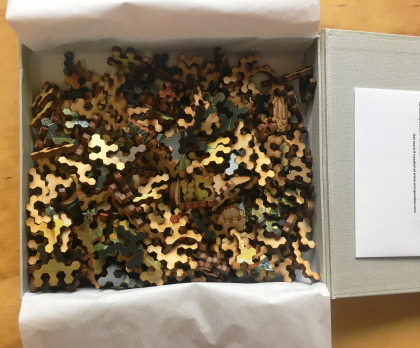
These pieces look fiendish! I’ve never worked with anything quite like these. The pieces look like interconnected hexagons or simple chemical formulae. In fact, while assembling, I swear I saw a piece that looked like a sugar molecule!!
What? you thought I’d reveal the secret that easily?? I had to work my way there, you can be patient.

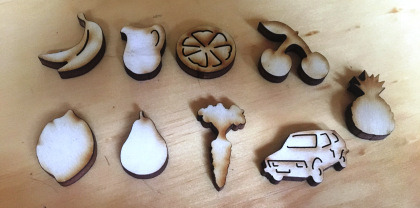
Artifact is known for their excellent whimsies (shaped pieces that tie into the puzzle’s theme), but I’ll admit that these stumped me for a bit. Fruit I could understand, but a car??

Okay, I have a blue bowl and fruits, maybe my car isn’t a car, but a van?? Oooh! Van Gogh!?!?
I have to admit, they weren’t kidding about the closer fit on the pieces! once in their proper place, the pieces cling together so well that you can’t fit anything between them. In some places, the lines become invisible!
Big Reveal Time!
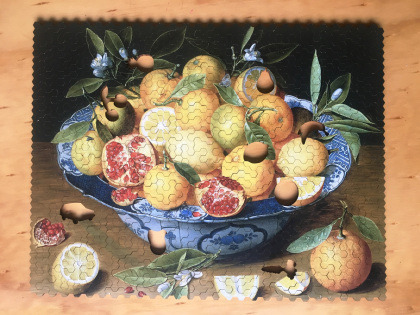
Minus the whimsies, of course. I’m not done, gang.

Under the pieces in the box, I spied this little note.
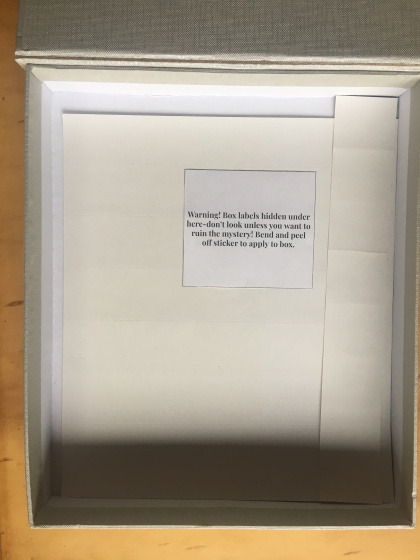
Once you’ve assembled the puzzle, it isn’t a mystery anymore, is it? That depends. If you have a large extended family like mine, you could loan out the puzzle and share the fun, or if you love the revealed image, you can use the provided stickers to decorate the top and sides of the puzzle box before shelving it for later use.
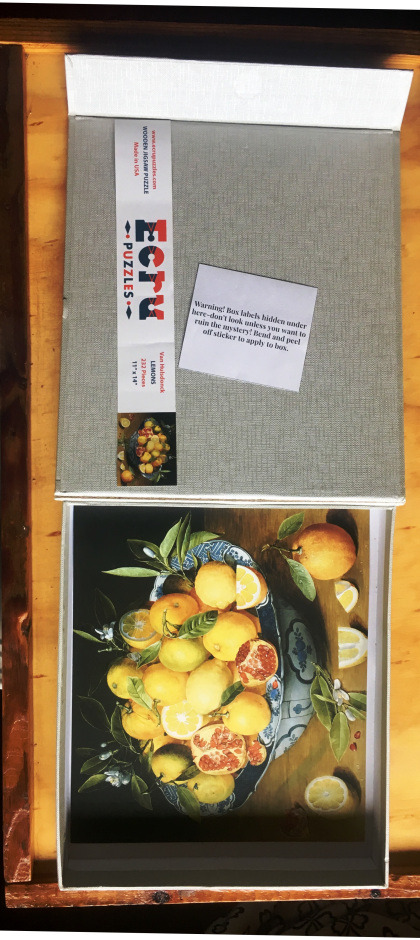
So not a Van Gogh, but a Jacob van Hulsdonck! This lovely mystery puzzle was his Still Life with Lemons, Oranges and Pomegranate.
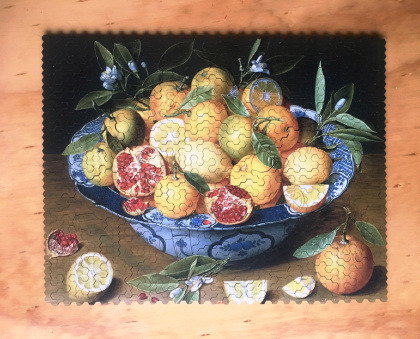
PUZZLE SPECS
Company: Artifact Puzzles
Title: Ecru Puzzles – Mystery Puzzle #1
Artist: Jacob van Hulsdonck
Designer: Jef Bambas
Year released: 2019
Pieces: 232
Cut-Style: Random
Finished size: 10″ by 10″ inches
Bonus poster: Yes
Made in USA
QUALITY:
Box: 10.5″ by 9″ by 2″ inches
Board: Thick and sturdy wooden pieces
Cut: Laser-cut
Image Quality: Excellent, great color saturation
Finish: Matte, with great color saturation
Puzzle Dust: Nonexistent!
Piece shapes: Irregular with plenty of themed whimsies
Piece Fit: Nice and tight!
Disability Notes: Other than the obvious issues with fine motor control with separating pieces that do no belong together, I found this puzzle to be both easy on my eyes and hands. The pieces are sturdy and can be worked with mild to moderately arthritic hands. While there are some dark sections to this particular puzzle, a bright lift was all I needed to see my pieces.
Where to buy: Ecru Puzzles – Mystery Puzzle #1 is no longer available, but Mystery Puzzle #9 is on the Artifact Puzzles website for $60 USD. New Mystery Puzzles are being added soon! No sticker shock, here guys! These are high quality, artisan puzzles that will last for decades if well cared for.
Artifact Puzzles : Website / FaceBook
Disclosure: I received a complimentary puzzle from the manufacturer in exchange for review. The opinions are my own.
Thanks for reading, and please click the Follow Button under my profile on the right side of the page. To support posts like this in the future, consider joining my Patreon!
The New Ecru - Mystery Puzzles No image, just pieces! Can you solve the puzzle? @artifactpuzzles #woodenpuzzle #woodenjigsaw #mysterypuzzle #puzzlereview #puzzle #jigsaw #disabledpuzzler #puzzler #review I'm a sucker for a good mystery. It piques my curiosity and I just can't seem to help myself!
0 notes